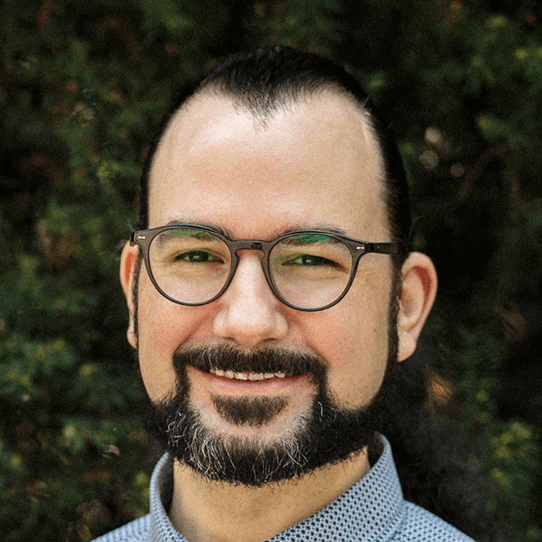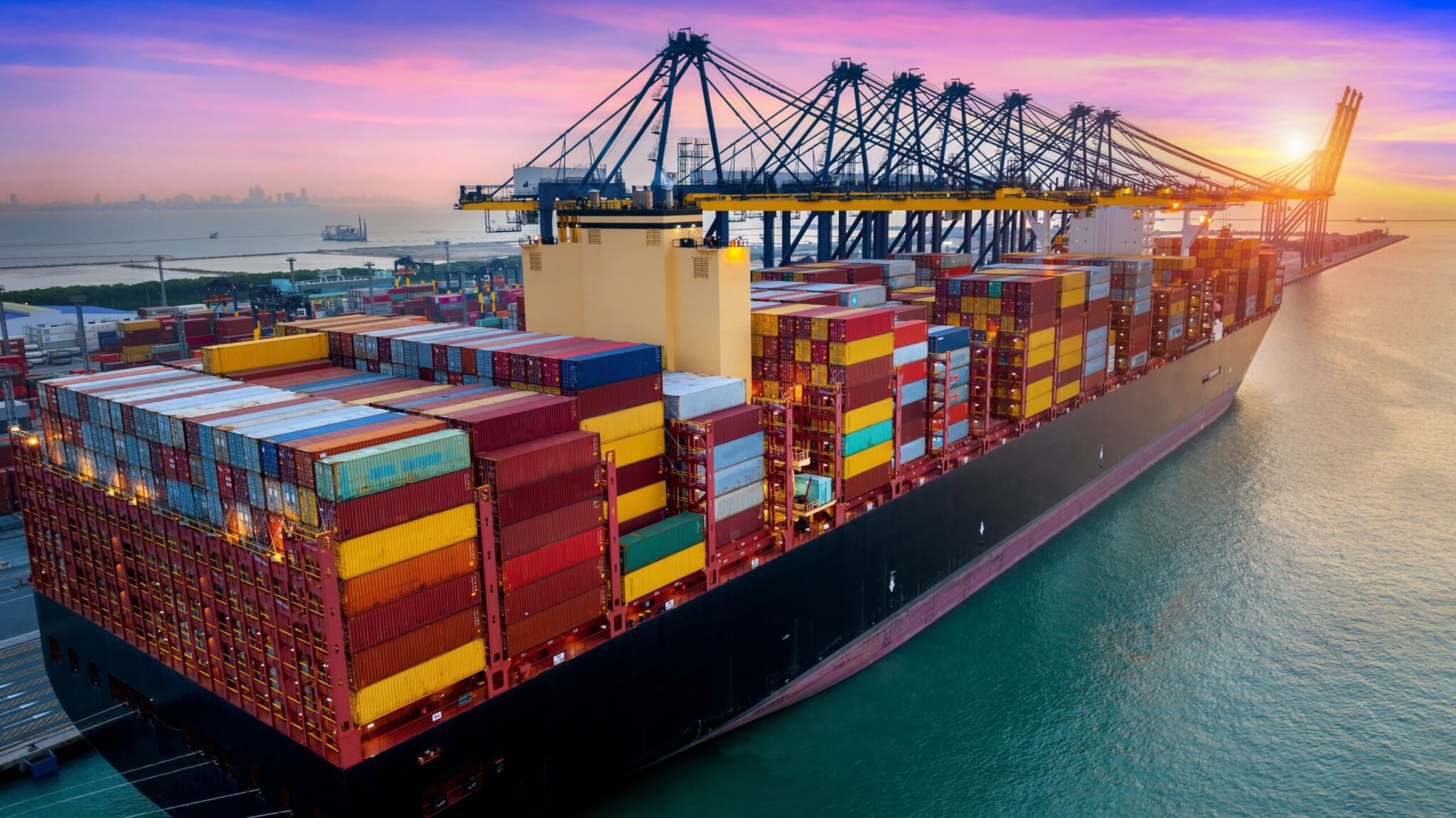
A promising solution for maritime shipping brings both opportunities and challenges.
A key sector for addressing the climate crisis is maritime shipping, which accounts for nearly 3% of global greenhouse gas (GHG) emissions. While maritime shipping emissions are traditionally considered hard to abate, viable solutions for decarbonizing the sector have become clearer in recent years — such as efficiency measures on ships, wind propulsion, and batteries and fuel cells.
As the technology pathways become clearer, the policy environment has increasingly supported transitioning toward a cleaner shipping sector. The International Maritime Organization (IMO), the global regulator of international shipping emissions, has adopted a goal of zero lifecycle (or “well-to-wake”) GHG emissions by 2050, with binding policy measures on pace for enactment this year. However, even the most optimistic forecasts indicate that a substantial share of the energy required for international shipping will still require fuels carried onboard vessels.
That is why it is necessary to find zero- or near-zero-carbon fuels that fit the unique needs of maritime shipping. One promising area is the development of “e-fuels” — low-carbon or carbon-neutral fuels synthesized using green hydrogen, which in turn is produced through electrolysis using additional renewable energy sources. Across much of the research on e-fuels in maritime shipping, ammonia has emerged as a viable option for the sector. However, widespread adoption will require addressing the challenges and risks associated with ammonia production.
Why is ammonia gaining momentum as a shipping fuel?
Ammonia has several qualities that make it a strong fit as a maritime shipping fuel. Most notably, ammonia does not contain carbon, so burning ammonia emits no carbon dioxide (CO2). Ammonia is much more energy-dense than hydrogen and requires less storage space on board. (It is important to note, however, that ammonia’s volumetric energy density is lower than conventional fuels, so the baseline amount of fuel storage on ships will still need to increase.)
Additionally, unlike hydrogen and liquefied natural gas (a fossil fuel increasingly used in shipping), ammonia does not require storage in cryogenic or high-pressure containers. Instead, ammonia can easily be stored in existing propane tanks.
Ammonia derived from coal and natural gas is relatively abundant and affordable, and its production is well-established in the fertilizer industry. Global ammonia supply chains can be adapted to the shipping industry, although supplying fuel to ships from the shore (a process known as bunkering) will require major infrastructure investments.
Overall, there is growing momentum for ammonia across the shipping industry. Shipping companies have already started ordering ammonia-powered vessels, and analysts project ammonia will make up approximately 35% to 50% of the marine fuel mix by 2050. However, ammonia production does bring significant challenges and risks that must be addressed before widespread adoption.
Addressing ammonia’s safety concerns
It is important to note that ammonia is highly toxic to humans and marine life. Acceptable exposure limits are very low (20 to 50 ppm), and concentrations above 300 ppm can irritate the eyes and lungs. Acute exposure above 2000 ppm can be fatal to humans within half an hour, and any spill to the ocean could harm marine ecosystems. The high risk to health and the environment makes safety the top priority in ammonia fuel adoption.
Existing international rules do not yet cover ammonia. Effective regulations are still under development, and the IMO adopted interim guidelines for ammonia-fueled ships late last year. Under certain conditions, ammonia-fueled ships will be operable by 2026. Meanwhile, industry associations are evaluating the safety risks of ammonia and have found that measures like lowering fuel tank temperatures or restricting access to spaces containing ammonia can mitigate risk to acceptable levels.
Challenges to scaling up green ammonia
While burning ammonia emits no CO2, ammonia production is still emissions-intensive. Currently, ammonia relies mainly on reforming methane, a process that produces significant CO2 emissions and thus is labeled “grey ammonia.” Methane reforming produces the hydrogen needed for the Haber-Bosch process, which combines the hydrogen with nitrogen from the air to produce ammonia. Global grey ammonia production is responsible for roughly 450 million tons of direct CO2 emissions per year, or around 1.2% of global emissions. The IEA estimates that on average, each ton of grey ammonia production emits 2.4 tons of CO2, slightly more than a passenger car in the United States emits in half a year. Without changes in production methods, the use of grey ammonia on ships would simply shift emissions up the supply chain.
Producing green ammonia, on the other hand, involves synthesizing the hydrogen via water electrolysis using additional renewable electricity. While the technology is proven, the scale of deployment does not meet current demand. Today’s global production capacity is about 200 million tons per year. Meeting the projected 2050 demand for maritime shipping will require at least 225 million tons per year Additionally, meeting the sector’s decarbonization goals will require significantly scaling up ammonia production while transitioning towards green ammonia.
Zero CO2 doesn’t mean zero emissions
Burning ammonia does not emit CO2; however, without the proper equipment and precautions, it can emit other harmful gases.
In theory, harmless nitrogen gas is the only emission associated with burning ammonia. In practice, however, combustion in ship engines can yield nitrogen oxides (NO and NO2), which are harmful to health and cause acid rain — and nitrous oxide (N2O), a greenhouse gas with a global warming potential 273 times greater than CO2. Ammonia also requires a high ignition temperature, and any unburned ammonia can escape through the exhaust. For every gram of ammonia fuel consumed, every milligram of N2O released from ammonia-fueled engines would reduce by around 25% the climate benefits of switching from fossil fuels to green ammonia.
Furthermore, ammonia emissions also reduce air quality by significantly contributing to the formation of particulate matter (PM2.5). It has been estimated that ammonia emissions from agriculture contribute to around 30% of PM2.5 formation in the United States and 50% in Europe. Unburned ammonia emissions from shipping could exacerbate this problem.
Managing these risks will require new ship engines that optimize efficiency while minimizing emissions — and manufacturers are already developing solutions. For example, a project in the United Kingdom secured 6.7 million USD to develop high-performance and low-emission engines and fuel cells; and leading marine engine manufacturers have initiated full-scale testing for large ammonia engines.
Closing the price gap between green ammonia and fossil fuels
Green ammonia is currently two to three times more expensive to produce than regular ammonia. As of early 2025, heavy fuel oil (HFO) prices ranged between 500 and 600 USD per ton, compared with green ammonia at 885 to 1,050 USD per ton. However, replacing conventional fossil fuels will require the equivalent of more than twice the amount of ammonia. In other words, green ammonia would cost between 1,900 to 2,250 USD for each ton of HFO replaced, amounting to a price gap of 1,400 to 1,650 USD per ton.
However, the price gap and production costs are projected to decrease as the technology for green ammonia matures and scales up. Policy support like carbon pricing and subsidies can help accelerate the transition, along with carbon emission trading mechanisms like the European Union Emissions Trading System (EU ETS). Some estimates show that such policy support could help achieve price parity between green ammonia and current fossil fuels between 2030 and 2035.
According to recent analyses by the Getting to Zero Coalition, reaching significant adoption of ammonia and other zero-emission fuels will require a carbon price of around 100 USD per ton of CO2 by the early 2030s. In practice, implementation could involve an IMO-led global levy or regional measures like the EU ETS.
Beyond carbon pricing, other incentives are gaining traction, including fuel subsidies or tax credits for green ammonia, government-backed R&D funding, and co-financing for pilot projects. For example, under the European Union’s FuelEU Maritime Regulation, until 2033, each unit of renewable fuels like green ammonia will count twice toward a ship’s GHG intensity reduction targets.
Advancing cross-sector collaboration and policy implementation
Ultimately, widespread adoption of ammonia will require close collaboration between governments, industry leaders, and research institutions. Given ammonia’s inherent health and environmental risks, unified standards and protocols are necessary to ensure it is handled and used as fuel safely. Joint industry projects and pilot programs like the Castor Initiative, Norway’s Green Shipping Program, and the ammonia bunkering trials in the Asia-Pacific aim to solve challenges around safety, infrastructure, and technology.
Policy support is another key enabler. The IMO’s 2023 greenhouse gas strategy created a long-term mandate that pushes the industry towards fuels like green ammonia. The transition will require big investments in technology, infrastructure, and supply chains, which can be de-risked with the right balance of carrots (like incentives, funding, and support for research and development) and sticks (like emissions regulations, fuel standards, and carbon prices). Good policy implementation will bolster the ongoing innovations and partnerships, allowing ammonia to mature from a promising concept to a practical, scalable solution for maritime decarbonization.

At the halfway point in the decisive decade for climate action, the global community faces a stark juxtaposition: despite meaningful progress, the challenges ahead remain immense. Amid great challenges, there is an even greater opportunity to bridge divides, scale effective solutions, and foster a sustainable future where humanity can thrive.
Dear colleagues and friends,
The global community faces a stark juxtaposition on climate action: despite meaningful progress in recent years, the challenges ahead are significant. Climate impacts are escalating just as important leadership gaps are emerging, and the stakes have never been higher.
For a second time, the United States — the largest historical emitter of greenhouse gas emissions in the world — is withdrawing from the Paris Agreement. This decision, along with federal funding freezes and the dismantling of USAID, underscores a vital truth: climate progress cannot rely solely on national government action, or on one country alone. Sustained, holistic, and collaborative efforts from all corners of the globe — spanning national, subnational, and local levels, and from the private sector, civil society, and government — are essential to addressing the climate crisis that is upending billions of lives and jeopardizing economies everywhere.
Yet, amid these great challenges, there is an even greater opportunity to bridge divides, scale effective solutions, and foster a sustainable future where humanity can thrive. Achieving this will require unprecedented collaboration and trust from every sector and level of society, including philanthropy.
The urgency of now
The evidence of a rapidly changing climate is all around us. Last year, 2024, was the hottest year on record, with the Earth’s average global warming exceeding 1.5º C for the first time. Record-breaking heat waves, droughts, wildfires, and flooding displaced millions of people, crippled infrastructure, and deepened food insecurity.
Globally, the cost of climate inaction continues to rise, with damages projected to reach USD 38 trillion annually by 2050. The main culprit is the burning of fossil fuels. While this helped drive growth and development in the past, it is no longer needed — we now have cleaner, more affordable alternatives. Fossil fuel use is responsible for the devastating climate impacts we’re seeing globally, including 4.2 million premature deaths from outdoor air pollution each year. Despite these enormous costs to society, fossil fuel industries continue to profit, buoyed by a shocking $1 trillion-plus in annual subsidies and tax breaks globally, even as they protect their own profits and spread disinformation to stall progress on the inevitable clean energy transition.
Shifting power dynamics in global climate leadership
As the United States steps back on climate, emerging economies and countries in the Global South are rising to fill the leadership void. Brazil, the host of COP30, is fostering global collaboration around climate ambition and halting deforestation. South Africa is pioneering public-private partnerships to ensure a just transition for workers and communities as they phase out coal and create green jobs. China is installing record amounts of clean energy and purchasing record numbers of EVs. Indonesia is scaling up its renewable energy capacity to peak energy sector emissions by 2030 and, while there is push-back, President Prabowo has indicated the possibility to bring forward the country’s net-zero target from 2060 to 2050. Mia Mottley, the prime minister of Barbados, is leading the charge to address the chronic indebtedness of those countries hit by the worst impacts of climate change.
Around the world, states, provinces, and cities are also stepping up as incubation hubs to try new approaches that can bolster economic development, benefit citizens, and tackle climate — creating solutions ready to scale nationally and internationally. And, while it is disappointing to see a number of corporate leaders backing away from net zero climate coalitions, many appear to be continuing steadfast in their approaches to minimizing climate-related financial risks and maximizing opportunities in the new green economy – because these simply make good business sense.
Scaling climate finance is essential to sustaining this momentum. Countries in the Global South are now slated to receive $300 billion annually by 2035 to help protect their people from climate disasters and transition their economies to low-carbon, with recognition that broader public and private financing needs to increase to $1.3 trillion per year. This will require both more investment and new financing approaches.
Now is the time to rebuild trust by showing how these finance flows can be delivered, even in the midst of tight fiscal budgets. For example, a push for innovative financing mechanisms is growing, like the proposed shipping and aviation levies, along with other measures supported by the Global Solidarity Levies Task Force, to raise billions to fund climate action. In April 2025, the IMO will consider adopting a greenhouse gas levy for shipping, which could be a promising start.
Building bridges across divides
Regardless of political rhetoric, real-world evidence shows that climate solutions are already delivering tangible benefits for people. Electric transportation, clean cooling, and renewable energy are creating jobs, reducing electricity and gas bills, cleaning the air, protecting health, and supporting energy independence.
Take Texas as an example: This Republican-led state leads the United States in wind power generation, saving up to $31.5 billion in electricity costs since 2010. In other words, clean energy isn’t ideological — it’s economical. In 2024, 96% of all new power plants in the United States were carbon-free, because this was the right economic choice.
Despite these successes, fossil fuel defenders are sowing division by blaming renewables for rising electricity costs — when in reality, energy price increases stem from volatile fossil fuel markets, inflation, and grid infrastructure damages caused by extreme weather.
Redirecting fossil fuel subsidies to renewable energy infrastructure can not only stabilize costs and modernize aging grids but also build resilience, energy security, and long-term affordability. These targeted investments, along with efforts to tackle the spread of deliberate disinformation campaigns, are critical to making the right choices for economic growth and securing real benefits for households and communities.
Momentum and scaling solutions
Clean, efficient cooling solutions are critical as heat waves increasingly impact communities worldwide. The focus must now be on scaling proven strategies to maximize their impact in communities worldwide. In India, Energy Efficiency Services Limited’s Fan Hub program is transforming the market by deploying 10 million super-efficient ceiling fans, cutting costs and emissions while spurring manufacturer interest. Globally, the development of new super-efficient ACs could cut 68 gigatons of emissions by 2050 — the equivalent of just over a year’s worth of GHG emissions from all anthropogenic sources today. Philanthropy is working with manufacturers, governments, and other partners to bring these solutions to market faster.
The exponential rise in electric vehicles is another success story. The latest data shows that EVs accounted for more than a quarter of new passenger vehicles sold on average in the four major markets — the United States, the European Union, India, and China (according to a forthcoming report from the Drive Electric Campaign). This far surpasses what was seen only a few years ago as an ambitious target of 15% by 2026. Supported by philanthropy, Drive Electric’s Leapfrogging Partnership is now helping to bring the benefits of EV markets to other countries. In Rwanda and Kenya, for example, over 200 e-motorbikes have boosted driver incomes by 41% while reducing emissions.
In partnership with diverse stakeholders, philanthropy has been pivotal in scaling multiple transformative climate solutions by leveraging patient, risk-tolerant capital to accelerate innovation, unlock private-sector investment, and foster collaboration. With foundation funding for climate mitigation reaching $4.8 billion in 2023 — nearly tripling since 2019 — philanthropy is driving long-term progress. By amplifying effective approaches, philanthropy can help address global climate goals despite growing backlash.
Amplifying philanthropy’s impact in a decisive decade
The next five years are the most critical of this decisive decade for climate action. While one country is leaving the Paris Agreement, 194 countries remain steadfast in their commitment, demonstrating the resilience of global collaborative action and a recognition that tackling the climate crisis is the only sustainable growth path forward. At this moment, philanthropy must step up to catalyze trust, keep the momentum for ambition, and work with a wider range of partners to drive transformative progress and fight the strong headwinds of 2025. This means:
- Working collaboratively: Philanthropy can participate in collaborative giving platforms that allow funders to amplify existing initiatives and accelerate solutions that already exist. Together, we can maximize our impact.
- Backing grantees to win: Philanthropy must invest deeply in grantee capacity development and multi-year flexible, core support, especially in low-to-middle-income countries. In the current rapidly shifting operating environment, strengthening the capacity of all grantees to manage legal and security risks will be a particular priority. This is not a sprint, and these grantee partners are doing work that needs to be sustained over the long term.
- Thinking broader than just climate: Finally, philanthropy should embrace integrated solutions at the intersection of climate and the delivery of other societal goals, such as public health, economic development, human rights, and ecosystem resilience. Working together to align around common goals can multiply the impact of philanthropic funds, and build broader coalitions across political parties to support change.
This is no time for retreat or hesitation. It is a moment for courage and collaboration. Together, we can shape a sustainable, equitable future — one built on trust, innovation, and shared purpose.
In partnership,
Helen Mountford

ICM’s CEO Dr. Adrian Fernandez explains how the organization holds Mexico accountable to its international climate commitments.
Iniciativa Climática de México (ICM) is a nonprofit regranting organization that supports climate action in Mexico and works to elevate the country’s climate leadership. One of ICM’s priorities involves advancing efforts to raise Mexico’s climate ambition at the national level. With support from the Bezos Earth Fund (Earth Fund) and ClimateWorks Foundation, this work includes holding Mexico accountable to its Paris Agreement commitments as outlined in its Nationally Determined Contribution (NDC).
Under the Paris Agreement, countries are required to submit updated NDCs every five years — with each new NDC more ambitious than the previous one, based on the latest climate science. However, under its previous administration, the Mexican government’s climate policies regressed, threatening to undermine the country’s ability to deliver a sufficiently ambitious NDC.
Dr. Adrian Fernandez is ICM’s founder and CEO. In this Q&A with ClimateWorks, he recounts how ICM mobilized civil society groups in Mexico to advocate for a stronger NDC, despite political barriers. He also explains how philanthropy can learn from this success story and help countries around the world increase their climate ambition.
This interview has been edited for clarity and length.
Please tell us about your journey. What drove you to work on climate change, environmental policy, and philanthropy?
Professionally speaking, I like to say that I’m in my third reincarnation. I was first trained as an air pollution and health scientist: I completed my master’s degree and PhD in the United Kingdom and served as a postdoctoral researcher in the United States.
However, I soon discovered the role that science can play in influencing policy, and after I moved back to Mexico in 1995, I began my “second career” which was focused on government. At the Ministry of the Environment (SEMARNAT), I served as director general for Environmental Management and Information and as director general for Local, Regional and Global Pollution. Then, I served as president of the National Institute of Ecology, the institution responsible for providing scientific evidence to SEMARNAT.
Finally, after 17 years as a civil servant, I transitioned to the world of philanthropy, working with ClimateWorks Foundation, Hewlett Foundation, Oak Foundation, and the Children’s Investment Fund Foundation (CIFF) on building an international network of regional climate foundations (RCFs). The RCFs are organizations with deep place-based expertise that create and execute philanthropic strategies to drive climate progress in their respective regions. This work eventually led to my role as the founder and CEO of ICM, which was formally launched in 2016 with significant support from CIFF.
How would you describe ICM’s unique approach and its role in the broader climate community?
Like many of the other RCFs that emerged around the same period, ICM was launched as a re-grantor, serving as the intermediary to connect larger funders with grantee partners in Mexico — often smaller organizations, grassroots groups, local communities, and individuals. However, in building out the institution, ICM has taken on other major roles beyond regranting, including as a think tank, a convener, and an advocacy organization. These additional roles allowed ICM to raise funds from bilateral cooperation agencies working in Mexico.
Two approaches that we emphasize are strategic planning and an active focus on influencing decisions. This means that we allow ourselves to ask big questions and to be ambitious. As an organization, we are not just observers who track progress; we try to be part of what’s going on and make it happen.
What led ICM to develop its own version of an NDC for Mexico?
During the administration of former President Andrés Manuel López Obrador, who served from December 2018 through September 2024, the Mexican government took a major step backward in its climate and environmental policies. This included increasing fossil fuel use in the electricity sector while dismantling key environmental agencies by slashing budgets, ousting critical staff members, and appointing ideological allies.
The administration also allowed Mexico to flounder in its international climate commitments. Under the Paris Agreement framework, countries were required to submit updated NDCs in 2020 with emissions reduction targets that were more ambitious than their original 2015 submissions. Instead, however, Mexico submitted a hastily assembled NDC in 2020 that proposed mitigation targets similar to the original ones — which did not comply with the Paris Agreement’s requirement to increase ambition.
At ICM, we understood any country’s two most important obligations on climate. The first obligation is to keep submitting updated and more ambitious NDCs in accordance with Paris Agreement timelines. The second is to communicate to the world a pathway and a timeline to achieve net-zero emissions.
As a result, ICM worked in-house to draft our own version of an NDC proposal — a “civil society NDC” — which suggested that Mexico could update its mitigation goal to a 30% reduction by 2030 compared to the initial goal of a 22% reduction. We led the research for this work, producing a robust and comprehensive 60-page policy document backed by more than 600 pages of detailed technical analysis on inventories, models, scenarios, and baselines conducted by ICM. This type of ambitious work is normally done by countries and not small NGOs. In other words, ICM was essentially doing the homework for the government institutions that had been dismantled under the past administration with the hope that the new administration starting in 2024 would use this work as a basis for a new “official” NDC in 2025.
How did ICM collaborate with civil society to encourage the adoption of a more ambitious NDC?
While we initially planned to use our research and analysis behind the scenes, we eventually decided to release our work publicly and to coordinate civil society groups to advocate for a more ambitious official NDC. To do so, we convened our network of grantee partners, which includes NGOs, civil observatories, youth organizations, academic institutions, think tanks, and faith groups.
Together, we deployed strategic communications efforts, including a wide-reaching media campaign that encouraged the government to submit a new and more ambitious goal. The campaign also stressed that ongoing litigation by NGOs against the flawed 2020 NDC goal was not an impediment to submitting an adequate mitigation goal at COP27.
Collectively, I believe these efforts provided the government with the tools and confidence to adopt bigger goals. While they didn’t adopt our proposed NDC verbatim, they saw that our plans were feasible, which informed their final decision to submit an updated NDC in 2022 at COP27 with a more ambitious target of 35% in emissions reductions by 2030.
The Bezos Earth Fund (Earth Fund) and ClimateWorks Foundation were key partners in this effort through the Raising the Ambition of Climate Commitments (RACC) partnership. This included providing support for ICM and other RCFs to raise national climate ambition in emerging economies like South Africa, Indonesia, Brazil, and Mexico. Each RCF that was involved had the freedom to define their own proposals, and we directed this funding support toward our efforts to put the NDC together in-house.
What can NGOs in other countries learn from ICM about civil society’s role in pushing for increased national climate ambition?
The role of civil society is particular to the context of each individual country. However, broadly speaking, NGOs can play a role in holding governments accountable and working to ensure that countries comply with climate commitments.
More specifically, NGOs should work constructively with governments and help policymakers and cabinet members around the world better understand that climate is not just an environmental issue but the most critical threat to global prosperity and development. Particularly in emerging economies, it’s important to raise awareness of how decarbonization efforts can unlock opportunities for jobs, prosperity, and well-being.
Finally, any NGO working on climate and the environment should continue to make efforts to improve their technical capabilities and the robustness of their analysis. That way, they can go beyond raising voices for climate ambition and join efforts with government actors to use interdisciplinary approaches in identifying the most effective policies.
What’s next for ICM’s work on advancing efforts to increase Mexico’s climate ambition?
Leading up to the inauguration of President Claudia Sheinbaum, ICM actively engaged with senior officials in Mexico’s incoming administration — including key cabinets such as the secretaries for the environment, energy, and foreign affairs — to share critical strategic information and deepen their understanding of the climate priorities in the immediate term.
One heavy focus of our ongoing efforts is providing updated implementation pathways that outline the needed policy measures on climate change mitigation and identify the ones that will require significant investments. This analysis is critical for informing the administration on a portfolio of policy measures ready for enactment and implementation — with a recognition that success will require political will and prioritizing the right mix of achievable goals.
We will also explore financing options for these implementation pathways, which include providing cost estimates and analysis for key policy measures. Our priority is to avoid fragmented efforts and to secure significant, consolidated funding sources to drive substantial, impactful financing. For example, we’re leveraging our network to find viable financing solutions for deploying 30 gigawatts of renewable energy within the next six years.
How can philanthropy help drive more ambitious country-level climate commitments and action?
RCFs play a critical role as orchestrators for climate action by providing deep technical and political knowledge on its countries of expertise and what it would take to make a meaningful difference. In turn, funders need to trust and work closely with RCFs and local partners to provide support in an expeditious way.
That’s because timing is crucial when it comes to NDCs. While the technical work is intensive, it is often the easiest part of the process. The real challenge is putting together all the pieces to capitalize on the political moment in a country. That could involve applying outside pressure on the government, as ICM did during Mexico’s last NDC cycle — or working hand-in-hand with the government, which we hope to do with the new administration as they develop their next NDC.
Ultimately, climate funders talk a lot about the urgency of the crisis. The ways in which we collaborate should reflect that. In terms of climate action, there isn’t time to wait for more favorable political environments in countries. As a community, philanthropy has significant brain power and resources, and we must be willing to work together smartly, take some calculated risks, and increase our trust in RCFs and partner organizations — even amid adverse political circumstances. Driving meaningful climate action will require different strategies for different countries, and we must keep revising our approaches to reflect the level of ambition needed to meet the moment.

Countries in Africa, South America, and Southeast Asia are actively reshaping mineral dynamics to ensure that the associated mining benefits local economies and communities.
Transitioning from fossil fuels to a clean energy future will significantly reduce the strain on ecological resources. However, this systemic transformation requires an overall increase in key minerals. As governments, consumers, civil society, and investors amplify their calls for transparency about the environmental and social impacts of mineral extraction, this much-needed scrutiny is propelling the shift toward more sustainable and responsible practices.
The energy transition presents an urgent opportunity to build a responsible mineral supply that learns from past injustices and breaks free from the legacy of exploitative mining. For too long, foreign corporations and wealthy nations have extracted resources from low- to middle-income countries, leaving communities impoverished, the environment devastated, and human rights trampled.
Today, the wealthiest countries dominate discussions about sourcing the essential minerals for clean energy, while the countries supplying them continue to grapple with unethical mining practices and limited influence in global decision-making. This imbalance threatens to further entrench global inequalities and overlook the needs of many countries and communities.
Supporting a responsible mineral supply chain requires understanding local and geographic contexts — including the needs, hopes, and priorities of communities impacted by mining. This will require fostering true collaboration instead of imposing development projects driven by wealthy nations.
The following snapshots describe mineral extraction dynamics in countries in Africa, South America, and Southeast Asia. These countries play a critical role in the global supply chain and are actively reshaping mineral dynamics to ensure that the associated mining benefits local economies and communities.
Africa
In many African countries, centuries of colonial interference have opened the door for corporate exploitation that continues to deepen human rights violations, economic inequality, corruption, debt, and environmental degradation. African countries hold a significant share of essential mineral reserves for clean energy, raising expectations for a more prosperous future. However, past experiences have left many communities wary and even mistrustful that their interests will receive the attention they deserve.
The Democratic Republic of Congo (DRC) contains enormous mineral wealth and is the world’s largest supplier of cobalt, which is essential for lithium-ion batteries. In 2022, the DRC produced nearly three-quarters of all cobalt worldwide. Meanwhile, Guinea, Mozambique, Tanzania, Namibia, Zimbabwe, Zambia, and Kenya possess rich reserves of bauxite, cobalt, lithium, graphite, and copper, among other important minerals. Despite its coal mining legacy, South Africa is looking to shift its focus to manganese and platinum.
Countries across Africa are strategizing about how best to harness their mineral wealth, aiming to move up in the clean energy supply chain — and to ensure that the rewards of extraction bring maximum benefits to local economies. As a result, many African governments are crafting policies to ensure that raw minerals are not just extracted but also refined locally to boost domestic manufacturing. For example, Namibia and Zimbabwe have officially banned the export of unprocessed lithium to attract financing for mineral refining. Meanwhile, the DRC and Zambia signed an agreement in 2022 to develop domestic electric vehicle and battery production zones.
The rush for minerals has induced rapid mining expansion — often outpacing the enforcement of existing regulations — making it challenging to hold the mining industry accountable. This mismatch between industrial extraction and adequate regulations occurs around the world, including in the United States. In Zambia, nickel and manganese mining surged in 2022 under outdated regulations that failed to address contemporary human rights and environmental issues. These enforcement gaps leave communities vulnerable to abuses while legal protections for human rights and environmental defenders remain weak and inconsistently applied.
Despite their mineral wealth, many African countries face significant challenges in achieving sustainable economic and infrastructure development. Nonetheless, our partners like the African Climate Foundation are steering advocacy, engagement, and dialogue to drive efforts toward rewriting historical narratives of exploitation and extraction.
South America
Countries in South America are rich in mineral resources, with a centuries-old mining sector that dates to Spain and Portugal’s ruthless gold extraction. This colonial legacy has had devastating consequences on Indigenous communities, instilling deep mistrust and a fraught relationship with the mining industry. Today, modern mining projects continue to jeopardize these communities, bringing severe environmental disasters and violent conflicts in their wake.
South American countries are now widely recognized for vast lithium reserves — vital for electric vehicle batteries and clean energy storage — and contribute 35% of global lithium production. Currently, Chile is the world leader in lithium production. Together with Bolivia and Argentina, these three countries comprise the “lithium triangle” — a geographic area that holds over half of the world’s lithium reserves. Meanwhile, Brazil has one-fifth of the global reserves of graphite, nickel, and manganese.
Only a fraction of minerals in South American countries are currently accessible due to several complex and overlapping factors, such as a lack of investment, poor infrastructure, outdated geographical surveys, and location near fragile ecosystems or culturally significant Indigenous lands. Moreover, conflicts over mining are prevalent, with 45% occurring near biodiverse areas and Indigenous and local communities. In Chile, which hosts over 2.2 million Indigenous Peoples, many mining projects infringe on Indigenous lands. Additionally, the most resource-rich areas are often water-scarce and ecologically fragile, leading to conflicts over water shortage, pollution, and the disruption of Indigenous livelihoods.
As South American countries tap into the economic opportunities of the clean energy supply chain, they are beginning to implement new policies to protect their populations with the goal of rectifying the legacy of mining exploitation. Bolivia’s 2009 constitution declared that natural resources belong exclusively to its people. In 2023, Bolivian President Luis Arce Catacora proposed a collaborative lithium policy with Argentina and Brazil to innovate energy storage solutions that “will make it possible to overcome the use of fossil fuels.” Chile enacted mining tax reforms to increase contributions from copper and lithium producers. Chile’s Finance Minister Mario Marcel underscored that these reforms would help stop a long history of past abuses from the mining industry.
Ultimately, countries in South America seek pathways to economic prosperity that will uplift communities. Our partners at Iniciativa Climática de México and Instituto Clima e Sociedad are committed to realizing that vision.
Southeast Asia
Southeast Asian countries are significant players in the global energy transition and mineral supply chain. Indonesia and the Philippines account for 45% of global nickel extraction, with Southeast Asia’s production of nickel, rare earth elements, and manganese doubling in recent years. Indonesia saw a staggering 2,500% increase in nickel production between 2015 and 2020. Myanmar, Laos, Cambodia, and Vietnam also strive to develop their mineral resources, positioning themselves as emerging players in the sector.
Amid rising economic competition between the United States and China, Indonesia strategically implemented an export ban on raw minerals, mandating domestic refinement before export. This move aims to enhance the value of these minerals, boost domestic manufacturing, and position Indonesia as a global leader in clean energy technology production. Despite facing legal challenges from international mining firms, Indonesia has succeeded in growing its domestic refining processes.
For a country like Indonesia, growth in the minerals supply chain means a delicate balance between advancing energy transition goals, driving economic development, and protecting its rich biodiversity alongside the rights of local and Indigenous communities. Across the region, however, rapid development is outpacing regulatory progress, underscoring an urgent need for stronger platforms and capacity for civil society to engage with government and industry on critical issues like human rights, environmental integrity, and the welfare of communities affected by mining.
Amid Southeast Asia’s unique journey on minerals, developing a responsible supply chain in sync with economic development remains a critical priority for achieving success. In Indonesia, our partners at Viriya ENB are working to identify a multi-faceted strategy with an eye toward climate and sustainable development.
If we act now, we can build a responsible mineral supply
The clean energy transition offers an unprecedented opportunity for global collaboration and cooperation on a scale the world has never seen. However, to truly succeed, countries and communities in Africa, South America, and Southeast Asia — especially those historically exploited by mining and sidelined in policymaking — must be at the forefront of shaping the global energy transition. Climate solutions must advance their interests, uplift their aspirations, and reflect their realities — without overlooking their unique history, perspectives, and needs.
The future of mineral supply must be built with a deep commitment to responsible mining practices that safeguard human rights, protect ecosystems and biodiversity, and ensure economic benefits flow directly to the communities where these resources are found — ultimately to help secure a just, inclusive, and sustainable future for all.

Amid another year of deadly storms and record heat waves, there is a shrinking window of time left for investing in our ability to withstand and recover from climate shocks.
Hurricanes Helene and Milton in the United States and Storm DANA in Spain aren’t like the hurricanes of past generations — they are harbingers of a planet in crisis. Earlier this year, Cyclone Remal displaced nearly 1 million people in Bangladesh and India, floods in Kenya and Tanzania claimed over 225 lives, and Brazil’s Rio Grande do Sul experienced its worst flooding in over 80 years. Meanwhile, record heat waves in the Philippines and Thailand are sparking urgent health concerns for students, workers, and the aging population.
These extreme weather events are not isolated catastrophes. Driven by climate change, they intensify rapidly and are stronger and more frequent. They are a reminder that climate change is not a distant threat; it is here now and worsening with each passing day.
Conversations about addressing the climate crisis often focus on cutting emissions, on beating the clock before our “carbon budget” runs out. The same is true for adaptation and resilience. The world is racing against a closing window of time — an “adaptation budget,” if you will — for investing in the ability of communities around the world to withstand and recover from climate shocks.
Failure to act boldly means a future of escalating loss and damage, leaving communities exposed and vulnerable to the next wave of catastrophic events. Seized by this imperative to act, a diverse group of philanthropic funders from around the world has banded together to help catalyze investment in climate adaptation and resilience. Now is the time for funders to join the effort before the window of opportunity closes.
Escalating climate catastrophes demand immediate action
Within 24 hours, Hurricane Milton intensified to a Category 5 storm, slamming Florida with winds 10% stronger than previous hurricanes and 20% to 30% heavier rainfall. Warmer waters due to rising global temperatures (driven by climate change) supercharge storms, enabling them to intensify with alarming speed. This dangerous trend gives communities less time to prepare, as Floridians learned when Milton made landfall just 13 days after Hurricane Helene devastated the region — confirming research that rapid sequential storms are becoming more common.
The damage goes far beyond physical destruction. Loss of lives and livelihoods, displacement, food and water shortages, economic collapse, and rising health risks like malaria and dengue compound the suffering, especially for low-income families, people with disabilities, the aging population, and other communities vulnerable to climate impacts.
These disasters only deepen existing inequalities, amplifying the human cost of climate change.
In Bangladesh, families torn apart by Cyclone Remal are not only grappling with the loss of their homes, but they are also facing a future threatened by dwindling resources and uncertain recovery.
Rapidly scale adaptation investments now before our window closes
Jim Skea, chairman of the Intergovernmental Panel on Climate Change (IPCC), warns that at that current pace, global temperatures could increase by 3° C by 2100. To avoid catastrophic losses, philanthropy must immediately accelerate action and scale investments in adaptation and resilience.
“Failure to act boldly means a future of escalating loss and damage, leaving communities exposed and vulnerable to the next wave of catastrophic events.”
Investing in adaptation and resilience isn’t just about minimizing damage — it’s about supporting communities and working to ensure they have the tools needed to survive and thrive in a rapidly changing world. These investments are essential for protecting the futures of workers and communities. Key areas for investment include:
- Financial protection for communities through parametric insurance for heat, drought, and flood events to help ensure quick recovery after climate shocks.
- Infrastructure upgrades in coastal and flood-prone areas, including stormwater and wastewater systems, resilient ports, permeable pavements, and natural buffer zones to safeguard against rising seas and extreme weather.
- Climate-smart agriculture that uses drought-resistant seeds and sustainable farming practices to secure global food systems and protect farmers from increasing climate unpredictability.
- Advanced climate risk modeling and forecasting tools to help businesses, homeowners, and investors make informed decisions in a rapidly changing climate.
However, current funding is grossly inadequate. Researchers estimate that only $76 billion USD was invested in adaptation and resilience across all countries in 2022. For comparison, the United Nations’ latest findings show that adaptation financing needs in developing countries alone are nearly $400 billion per year.
The recent IPCC reports leave no room for ambiguity: without a massive increase in support for climate adaptation and resilience, the world will face far greater economic loss and human suffering. The International Chamber of Commerce estimates that extreme weather events between 2014 and 2023 cost $2 trillion for countries around the world, a number roughly in line with the 2008 global financial crisis. For low- and middle-income countries, the consequences will be catastrophic, worsening poverty, inequality, and displacement.
Philanthropy mobilizes to help prevent a world of loss and damage
The world is struggling to close the adaptation finance gap against a shrinking window of opportunity. Philanthropy can step up and play a unique role — not just as a funder but as a catalyst to unlock public and private funding.
Convened by ClimateWorks Foundation, 21 leading philanthropic funders issued a call to action at COP28 in Dubai in 2023, sounding an alarm on the need to scale up adaptation investments without delay.
“The United Nations’ latest findings show that adaptation financing needs in developing countries alone are nearly $400 billion per year.”
The call to action led to the formation of the Adaptation and Resilience Collaborative for Funders (ARC), which has grown to a diverse group of over 60 philanthropies from five continents that fund across various issue areas. Throughout 2024, ARC hosted funder learning sessions to inform, mobilize, and identify opportunities for collaboration. In July, the collaborative responded to the UN call to action on extreme heat by investing an initial $50 million in climate adaptation and resilience efforts.
At COP29 in Baku, ARC released a first estimate of foundation support for adaptation and resilience, enhancing transparency and highlighting the opportunity to scale support. The analysis revealed at least $600 million in annual funding in 2023, with a projection of between $650 million and $700 million in 2024. These projections likely underestimate philanthropic support, which can be challenging to measure due to the cross-cutting nature of adaptation funding. Despite the likely underestimation, we know philanthropy needs to do more to scale its support.
We are energized by the response to the funder’s call to action and the growth of the collaborative over the last year — and we’re rolling up our sleeves. Guided by a shared vision, we are now developing an overarching strategy for philanthropy that includes creating a multi-donor adaptation fund to ensure that workers and communities have the means to adapt, survive, and thrive in the face of an increasingly volatile climate.
For more information, funders can reach out to adaptation@climateworks.org to learn more and get involved.
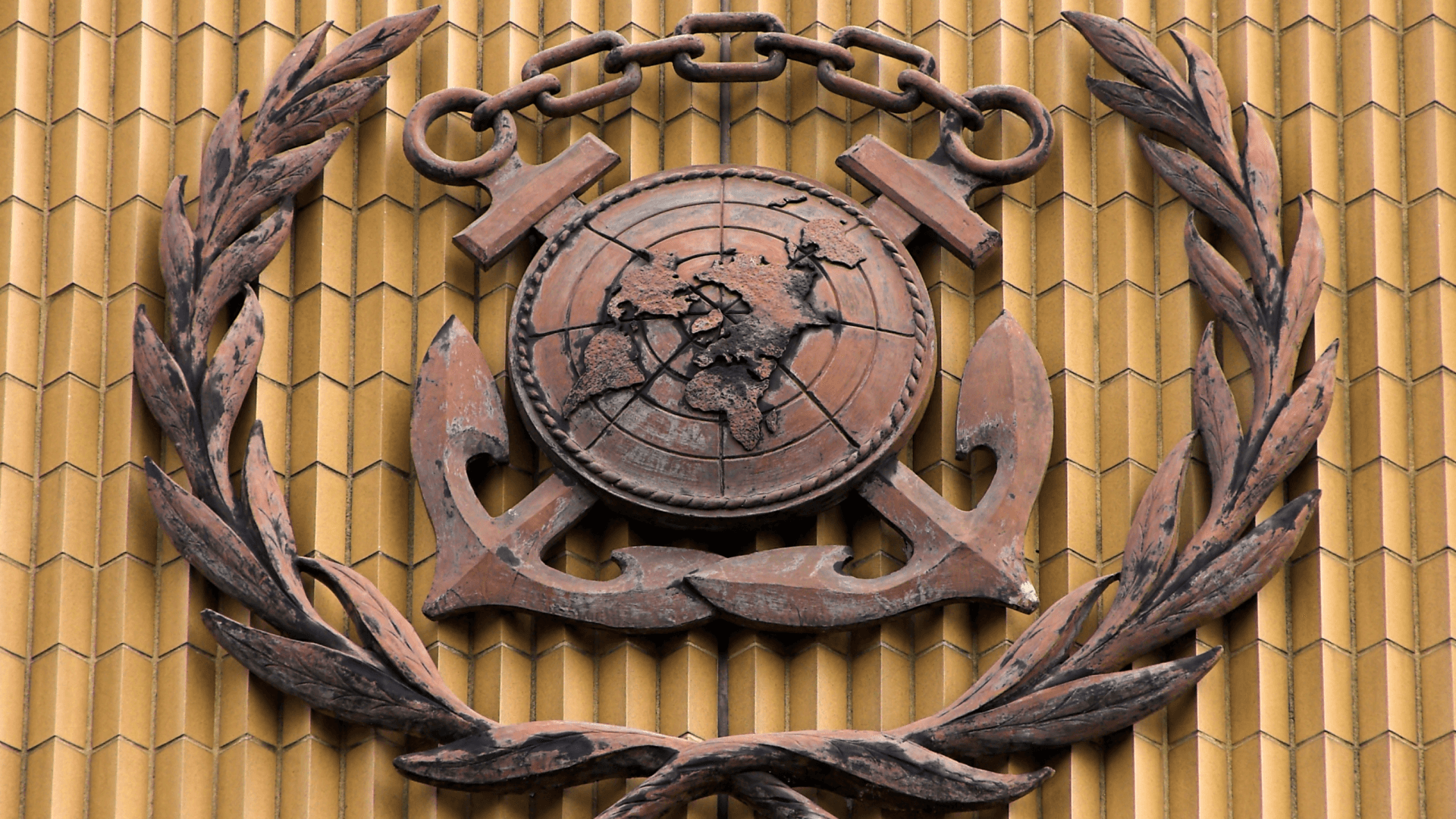
The International Maritime Organization (IMO) is navigating ways to turn its net-zero commitments into action.
In July 2023, the International Maritime Organization (IMO) took a historic step by committing to achieve net-zero emissions in the shipping sector by around 2050. This goal represents a transformative shift for one of the world’s most polluting sectors, offering an opportunity to reduce environmental harm while delivering benefits for communities worldwide.
The IMO’s Marine Environment Protection Committee (MEPC) convened in London from September 30 to October 4, 2024. At the meeting, IMO member states and other participants focused on advancing new policy measures to reduce greenhouse gas (GHG) emissions in shipping.
The IMO’s current discussions now center on how to turn its ambitious commitment into action, with proposals including a Global Fuel Standard (GFS), a carbon levy, and tighter efficiency standards. Climate advocates (including ClimateWorks grantee partners) and some country governments have championed a combination of these measures — which, if set at ambitious levels, can help ensure a timely and just transition for the shipping sector. Below are the key outcomes from the IMO meetings:
1. Widespread support for a carbon levy
More countries have voiced support for robust carbon pricing — including representatives from Africa, Pacific Island countries, the Caribbean, and the European Union, as well as from other climate-vulnerable countries. A carbon levy would discourage polluting fuels while generating revenue to fund a just transition, particularly to support climate-vulnerable regions on cleaner energy adoption.
2. Majority backing for a fuel standard and carbon levy combination
A clear majority now supports combining a global fuel standard with a carbon levy. This dual approach is critical because it accelerates the shift to cleaner shipping technologies while raising the necessary funds to support countries in making this transition. Climate advocates have prioritized the alignment of these two measures to help ensure that emissions reduction efforts are paired with meaningful financial mechanisms.
3. Full life-cycle emission accounting gains ground
A significant topic of discussion at the latest IMO meeting was the growing support for accounting for fuel emissions across their entire life cycle, from extraction to use. This holistic approach is essential as it helps ensure accurate accounting for the full environmental impact of fuels like liquified natural gas (LNG) and unsustainable biofuels. Such accounting practices would help hold the industry to higher environmental standards.
4. Stronger “strive” targets gain traction
A majority of relevant parties are now focusing on the higher “strive” targets set in the 2023 IMO strategy, which aims to set a more ambitious bar for fuel standards. These targets are critical in ensuring that the shipping sector makes faster progress in cutting emissions. Tougher targets mean stricter regulations on the types of fuels ships can use, which will push the industry toward adopting greener technologies and practices at a faster pace.
5. Carbon Intensity Indicator (CII) Review
The recent IMO meeting included discussions on the review process for the Carbon Intensity Indicator (CII), a key efficiency measure for the shipping sector. While the review will be divided into two phases and falls short of an immediate and ambitious overhaul, it leaves the door open for a deeper revision in the future. Keeping the option of stronger efficiency standards on the table is crucial for ensuring that the shipping sector continues to improve fuel efficiency and reduce emissions.
6. Expansion of emission control areas (ECAs)
The IMO adopted two new emission control areas (ECAs) in the Canadian Arctic and Norwegian Sea, and there was support for a potential North Atlantic ECA, which could be formally proposed at the next meeting. ECAs require the use of fuels that limit harmful emissions such as nitrogen oxides (NOx), sulfur oxides (SOx), and particulate matter. These areas are critical for protecting both the environment and public health in sensitive regions, especially where Arctic ecosystems and communities are at risk.
While these are all encouraging developments, the outcomes of the IMO’s efforts will hinge on the final round of negotiations in April 2025. Discussions at the session will focus on the implementation of a price on GHG emissions, the establishment of a global fuel standard, and the enhancement of vessel efficiency standards.
In other words, everything is still on the table and critical decisions are yet to be made. Nonetheless, the momentum built during the recent discussions provides a hopeful signal that shipping, a vital but highly polluting industry, can transition to net-zero emissions in a way that supports people and the planet.

The clean energy transition must avoid replicating the exploitative mining practices of fossil fuel companies and other extractive industries.
The rapidly accelerating global energy transition requires minerals to produce core components of electric transportation and clean energy technologies such as wind turbines, solar panels, and batteries. These minerals, including nickel, graphite, cobalt, copper, and lithium, among others, are found in various regions around the world — such as South America’s “lithium triangle,” the varied mineral wealth of the Congo, and half the world’s nickel supply in Indonesia.
The energy transition presents a unique opportunity to reshape mineral supply dynamics so that mining contributes to resilient, prosperous, and healthy communities. However, Indigenous Peoples and communities around the world have suffered from the consequences of irresponsible mining, such as deepening inequality, rising conflicts, and environmental degradation. A responsible mineral supply chain is necessary to help rebuild broken trust and ensure the energy transition does not replicate unjust and exploitative mining practices.
At ClimateWorks, we are actively seeking the insights and aspirations of our local partners around the globe to shape our collective effort to build a responsible mineral supply. Recently, I spoke with two regional leaders — Davidzo Muchawaya based in South Africa, and Pochoy P. Labog based in Indonesia — to gain their unique perspectives on the legacy of mining and their hopes for the clean energy transition.
Davidzo is the Africa Regional Lead for the Initiative for Responsible Mining Assurance (IRMA), an organization that sets a globally recognized, rigorous, and best practice standard for the mining industry. Pochoy is the Southeast Asia Researcher and Representative with the Business and Human Rights Resource Centre (BHRRC), which monitors the human rights impacts of more than 10,000 companies worldwide.
This interview has been edited for clarity and length.
What is your organization’s role within the broader ecosystem of organizations working on minerals in your regions? How do you collaborate?
Davidzo Muchawaya: IRMA is three things. It is a voluntary best practice mining standards and a process for independently measuring mines’ performance against that standard. It is also an organization overseeing the standard and measurement processes with representatives of affected stakeholder groups equally governing us: mining, purchasers, finance, organized labor, advocacy NGOs, impacted communities, and Indigenous rights holders. IRMA’s contribution to broader collaboration stems from our focus on capacity building among our stakeholders to help them better understand how to use our tools. We engage stakeholders, including the BHRRC, through regular outreach about engagement on mining issues and upcoming audits.
As a regional lead in Africa, I engage with civic organizations, impacted communities, organized labor, and other groups and regularly solicit feedback on our audit system and tools. IRMA’s vision is a world where the mining industry respects human rights, provides safe and healthy working conditions, minimizes environmental harm, and leaves positive legacies.
Pochoy P. Labog: BHRRC is an international non-governmental organization established in 2002. Our work combines local and global action, focusing on natural resources, labor, and technology. We support local actors in their struggles for justice while taking grassroots concerns internationally and working to drive systemic change. We monitor the human rights impacts of more than 10,000 companies worldwide.
To monitor mining companies, we reach out to see if companies would like to respond to any of our allegations before we publish our findings. We present our research fairly and often get a reasonable response rate from businesses that want to increase their social capital and be seen as respecting rights.
What is the discourse on minerals for the energy transition in your regions?
Muchawaya: The discourse on energy transition minerals across Africa is urgent and complex. While the discussion about conflict minerals has been going on for years, the accelerating energy transition has spotlighted the negative impacts of extracting minerals needed for the energy transition, and how to justly source them going forward. These minerals include cobalt, lithium, graphite, and copper deposits. Dominant themes for mining companies, host communities, and organized labor include human rights abuses, workers’ rights issues, and environmental harms. There are documented examples of these concerns in the Democratic Republic of the Congo, Namibia, Zimbabwe, and Mozambique to mention a few.
Today, we’re hearing more talk from mining companies about protecting local communities and prioritizing environmental protection while creating decent jobs, inclusive growth, and positive legacies — a significant shift from an industry that’s negatively impacted people and the environment in Africa. IRMA exists in part to transform that talk into meaningful action.
Labog: In my opinion, the current discussions about just transition have not adequately addressed the issue of mining. Only recently have human rights and climate organizations started to discuss a just transition that includes mineral sourcing and mining. When we talk about governments and businesses, they see the transition to renewable energy and mining minerals as revenue-generating opportunities.
Indonesia, a key country for nickel processing, wants to be the leading global supplier of electric vehicles. The Philippines intends to follow the Indonesian model, particularly in encouraging nickel processing. Meanwhile, Myanmar is rich in heavy rare earth elements that are vital ingredients for the magnets used in electric vehicles and wind turbines. These mines are highly unregulated due to the country’s military rule, and the ongoing conflict exacerbates their impacts.
What are the critical mining challenges in your regions, what are the underlying causes, and what are the barriers to addressing them?
Muchawaya: The first challenge that comes to mind is the inconsistency in enforcing existing regulations. Modern mining is growing more complex as it rapidly scales to meet the demand for minerals. Legislation often falls far behind the complexities of mining, and governments can find it challenging to match the rate at which the industry is evolving. This is why advocacy is essential in pushing governments to act and improve mining industry practices.
In Africa, governments sometimes face challenges in implementing and updating laws effectively. That’s where the IRMA Standard for Responsible Mining and assessment process can help. Through the public release of IRMA audit reports — which independently assess mines’ performance against the best practice IRMA Standard — we create unprecedented transparency about mining operations. We provide valuable information for companies to make their mines more responsible, for purchasers and investors to make better decisions about where to buy and invest, and for communities and civil society to work with governments to improve oversight. IRMA is a voluntary standard that can show governments a better way, but it is no substitute for government oversight that provides true accountability.
Labog: Mining is considered a revenue-generating activity, often at the expense of Indigenous Peoples and local communities. We see this in Southeast Asia, where government regulations are relaxed or not thoughtfully implemented. Indonesia, which has a Just Energy Transition Partnership, is processing nickel using smelters powered by coal plants. Because of the focus on profit, civil society organizations that advocate for impacted communities are threatened with lawsuits or imprisoned, particularly in less democratic spaces like Vietnam.
The issue of jurisdiction is often vague in Indonesia, while mining interests frequently undermine the agency mandated to protect Indigenous Rights in the Philippines. These challenges lead to uncertainty about who permits a mine. Consequently, Indigenous Peoples and other affected communities are often left out of the decision-making process. To address this pressing challenge, governments must urgently implement regulations that empower affected communities with more decision-making power and ensure the protection of human rights and the environment. Simultaneously, the business sector must increase its due diligence and transparency to exert pressure on companies and their investors while respecting rights across their supply chains.
What can contribute to stronger advocacy for responsible mining and supply chains?
Muchawaya: We need to focus on the communities that bear the brunt of mining impacts. They are telling us they must build their expertise and capacity to engage effectively with the mining operations in their midst and different sectors. Funding is necessary for research and legal representation to sustain their advocacy and campaign initiatives. IRMA supports these communities and civil society by developing tools that help them engage with mining sites effectively, particularly audit reports, which give them an independent auditor’s opinion about how a mine scores against the 400+ requirements in the IRMA Standard. And perhaps even more importantly, why the auditor gave the mine the scores on each requirement.
Labog: I agree with Davidzo that we need to build the capacity of local organizations and establish evidence through research that enables them to influence policymakers and companies. We must also increase support for advocacy efforts that map supply chains from the ground up in partnership with local civil society organizations.
How can philanthropy support efforts for responsible mining?
Muchawaya: Philanthropy can help fund critical initiatives and develop new technologies to monitor mining activities to support transparency and accountability. With funding from USAID through the Just Energy Transition Green Minerals Challenge, we’re working with NGOs, affected communities, and labor groups to create at least three new tools to help communities and workers access IRMA tools and audit reports, enhance accountability and transparency in the mining sector, and add to the measures that are being put in place to reduce harm.
Labog: Philanthropy can help fund legal assistance to access remedies. Filing cases in many countries is complex, and funding for this work is insufficient. One of the cases we won in the Philippines took 20 years. That’s why extraterritorial laws are so important. Taking on companies in their home countries would be a significant step toward addressing the human rights impacts of mining.
What is your vision for mining in your region and what are the most significant opportunities for responsible mining?
Muchawaya: My vision for mining in Africa is an industry that profoundly respects human rights and the aspirations and needs of communities — one that provides safe, healthy, and supportive workplaces, minimizes harm, leaves positive legacies, and equitably distributes the benefits of mining to local communities and workers. This vision might seem far-fetched, but it’s achievable if governments, labor organizations, mining companies, civil society, and stakeholders work together.
One central element to that vision is robust stakeholder engagement, where impacted communities are not just consulted when mining is operational but are integral to the design and planning process. It is crucial that the needs and aspirations of communities shape how and when mining takes place. I’d also like to see grievance mechanisms that are effective in remediating harm caused by operations.
Labog: With the renewable energy transition, I’m reminded that most carbon emissions come from wealthy countries while most transition metals are found in the Global South. We must seize the moment to ensure that the energy transition moves away from the legacy of extraction that has deepened inequality.
BHRRC has core principles like shared prosperity. We envision business models that drive the clean energy transition in a way that works for our communities, with workers’ rights as a critical component. Governments and companies must shield workers and communities from harm and minimize human rights and environmental risks. We also need fair negotiations that bring impacted communities to the table throughout the operational life cycle with free, prior, and informed consent.
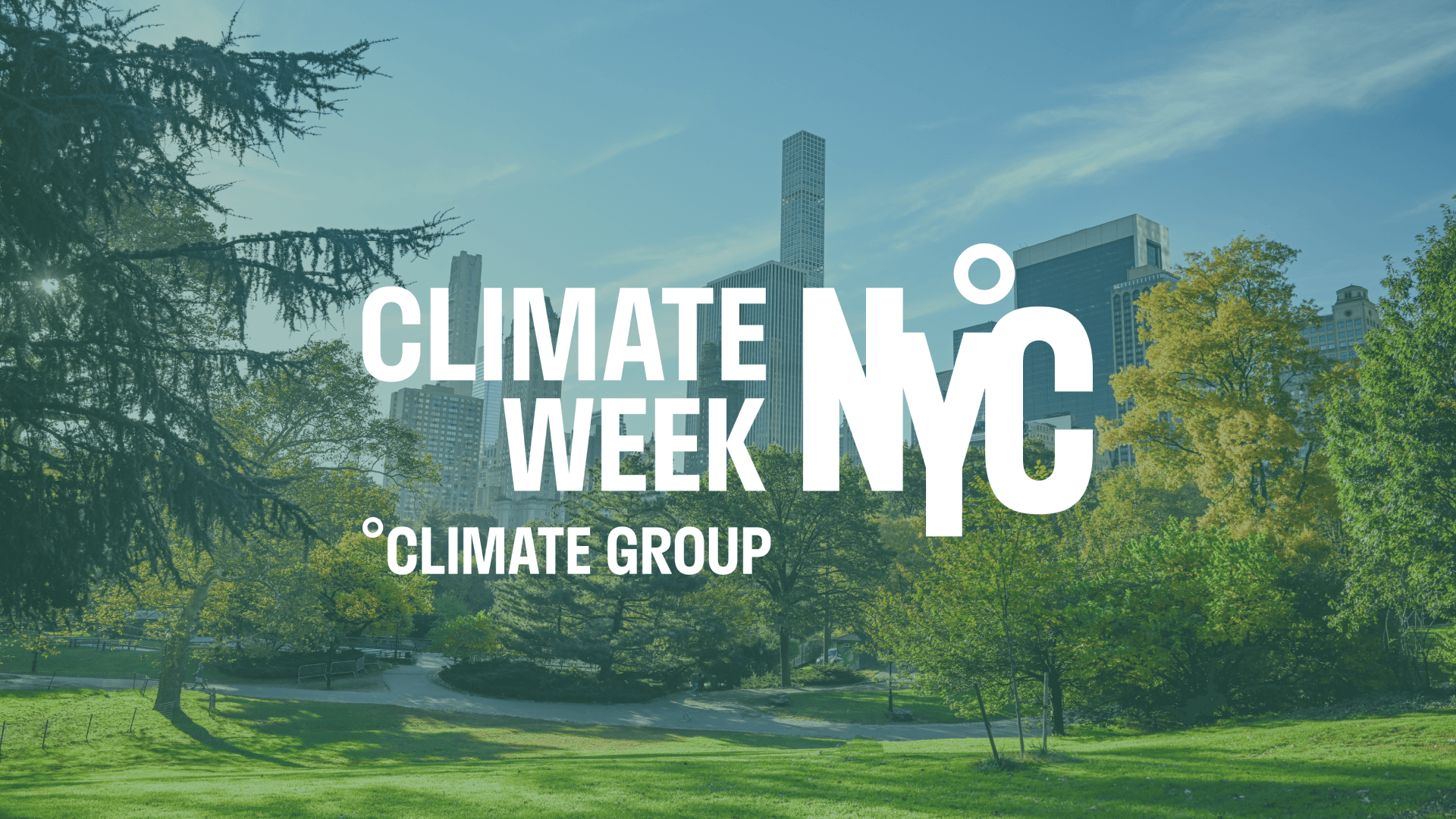
Now is the time to drive climate action that helps build healthy, resilient, and thriving communities today and for generations to come.
This year at Climate Week NYC, global leaders from across business, government, and civil society will converge to share information, challenge the status quo, and advance bold ideas on climate.
Today, climate action is an engine that drives sustainable development and strengthens economies. Now is the time to push for ambitious climate action that centers people, improves public health, and saves lives.
ClimateWorks Foundation helps philanthropy drive change by collaborating with implementing partners from around the world to advance transformative climate solutions that benefit people and the planet. From September 22 to 29, 2024, ClimateWorks will join a vast network of change-making partners in New York for Climate Week to listen, lead, and participate in a variety of Climate Week sessions. Below, we highlight a selection of events that we recommend following — whether you’re attending in person or participating online.
ClimateWorks and partners at Climate Week:
Opening Ceremony
Sunday, Sept 22; 1:00 PM – 6:00 PM EDT – more information
The Opening Ceremony launches Climate Week NYC each year and is attended by hundreds of world-leading politicians, business executives, and civil society representatives. They’ll share their global outlook on driving climate action and igniting progress through engaging interviews, discussions, and major announcements. The live-streamed event is free and open to all and will feature multiple members of our community including Jessica Anderen, the CEO of IKEA Foundation, in a discussion about ClimateWorks’ Drive Electric Campaign Leapfrogging Partnership.
Strengthening Civic Engagement and Public Institutions for the Common Good
Monday, Sept 23; 9:00 AM – 10:30 AM EDT – more information
2024 is a pivotal year. Nearly half the world’s population is headed to the polls for national elections. The results will have a significant impact on civic space, governance, and the role of institutions for years to come. However, as essential as elections are to build a just and inclusive society, they are a blunt and episodic tool. Looking beyond the election year, how can we redefine the relationship between ordinary citizens and public institutions — from one of fear or disaffection to one of hope and engagement? What does it take to defend democratic norms and processes in a time of closing civic space and rising mistrust in public institutions? What is the local and global infrastructure we need to deepen democracy?
We invite you to join a forward-looking dialogue with leaders on the frontlines of protecting and strengthening democracy. We will look at how civil society engages with state institutions, strategies that work to reimagine the relationship, and concrete ways to strengthen movements for justice and democracy.
Hosted by Namati
Donors Collaborative In-person Workshop
Monday, Sept 23; 9:00 AM – 11:00 AM EDT
This annual workshop offers a unique chance to discover Youth Climate Justice Fund’s (YCJF) impactful efforts, engage with a vibrant community of over 15 funders, as well as exchange insights and best practices on supporting youth-led socio-environmental initiatives.
Hosted by Youth Climate Justice Fund
A Digital Backbone for Climate Data: A Collaborative Summit
Monday, Sept 23; 9:00 AM – 1:00 PM EDT – more information
The lack of useful, publicly available data is a major roadblock holding back climate action. For example, after 20 years of climate action, cities cannot make sense of their progress or promising trends based on their data. Access to finance, coordinated multilateral action, and communicating progress all rely on access to data and information that is able to be combined together for insights. ClimateWorks’ Jean-Charles Seghers will moderate a panel.
Hosted by Climate Champions Team
Enlisting Sunlight in the Fight Against Climate Change
Monday, Sept 23; 9:00 AM – 1:00 PM EDT – more information
Climate Resolve is hosting a breakthrough event on the global and local benefits of deploying cool surfaces (roofs, walls, and pavement). “Enlisting Sunlight in the Fight Against Climate Change” will cover the potential for cool surface deployment in our built environment to (1) improve the Earth’s global energy budget by reflecting sunlight back to space, mitigating the greenhouse effect; and (2) protect public health by cooling temperatures at the local scale, lessening the urban heat island effect. Axum Teferra, ClimateWorks’ Senior Associate Director of the Clean Cooling Collaborative, will moderate a panel.
Hosted by Climate Resolve
Just Bumps in the Road? – How Can Leadership in EVs Smooth the Transition to Clean Transport
Monday, Sept 23; 3:00 PM – 4:00 PM EDT – more information
While electric vehicles are on the rise globally, the fastest growth is in places with strong and clear government policies. Communities in emerging markets across Africa, Latin America, and Southeast Asia are already experiencing these benefits thanks to innovative business models and ambitious government commitments to clean vehicles of all kinds.
This event, part of Climate Week’s The Hub Live, will include Drive Electric Campaign Director Rebecca Fisher speaking to how the Leapfrogging Partnership works with regional and local leaders to enable strong government policies that can close the gap between leading and emerging markets, supercharging the shift to zero-emissions transport.
Hosted by The Climate Group, sponsored by ClimateWorks’ Drive Electric Campaign
Mobilizing Financing for Electric Two- and Three-Wheelers
Monday, Sept 23; 4:00 PM – 6:00 PM EDT – more information
This event gathers stakeholders such as multilateral development banks (MDBs), philanthropists, corporate fleet platforms, regional financiers, and creditors to identify ways to mobilize financing for the electric two- and three-wheeler (e2/3W) transition. It explores financing solutions to increase the supply of e2/3Ws for all purposes including high mileage rideshare and cargo use and examines how innovative financing can reduce costs for e2/3W consumers. Discussions highlight pioneering financial approaches to make e2/3Ws more affordable and readily available, emphasizing the roles of stakeholders in driving investment and supporting the electric mobility transition. They also focus on involving local financiers to create lasting solutions and manage currency risk effectively. The insights gained aim to inform policymaking and the development of financial products to expand the supply and demand for e2/3Ws.
Hosted by RMI and Uber
Accelerating the partnerships between Sovereign Wealth Funds, institutional investors and governments on clean energy and transition
Monday, Sept 23; 8:30 AM – 10 AM EDT
The session, anchored by ClimateWorks, One Planet Sovereign Wealth Funds and hosted by Mubadala Investment Company, will explore how sovereign wealth funds (SWFs) and patient capital pools can better engage with governments to foster partnerships for implementing clean energy and sustainable project roadmaps, as well as capacity development.
The convening aims to strengthen the renewable energy ecosystem by showcasing case studies of successful project development and policy reforms in emerging markets and developing economies (EMDEs) that have facilitated private capital deployment. Critical discussions will focus on enabling best in class policy development, bankability, and investment needs of both investors and governments to advance the formation and implementation of vital renewable energy and sustainable projects.
Stocktake on Just Transition: How is South Africa Doing?
Tuesday, Sept 24; 8:00 AM – 10:00 PM EDT
This is a funder-focused panel and discussion on meaningful progress and emergent challenges on just transition planning and implementation in South Africa followed by an exploration of the potential pathways for philanthropy to support success in South Africa’s just transition efforts.
Hosted by ClimateWorks and the Ford Foundation
RMI at Climate Week NYC: It’s Time to Re-Energize
Tuesday, Sept 24; 8:45 AM – 3:15 PM EDT – more information
Four story-sharing sessions will be held: how the private sector, in partnership with RMI, is leading climate action; how slashing methane can solve short-term climate goals; how communities in the United States are benefiting from the Inflation Reduction Act (IRA); and how we can change hearts and minds in the fight against climate change. This dynamic program will feature RMI experts and partners from across industry, government, philanthropy, and community-based organizations.
Hosted by RMI
Trade and Climate: Scanning the Horizon for Emerging Geopolitical Signals
Tuesday, Sept 24; 9:00 AM – 12:00 PM EDT
This event will explore recent findings at the intersection of trade and climate (including topics such as the impacts of tariffs, investment treaties, and imported emissions) and how geopolitical dynamics are shaping and shifting the landscape of international trade. Attendees will have the opportunity to dive deeper into the implications of emerging geopolitical signals of change on a handful of trade-related topics in small groups.
Hosted by ClimateWorks and European Climate Foundation
Launch celebration: Whose planet? The climate justice podcast
Tuesday, Sept 24; 11:00 AM – 12:00 PM EDT – more information
Systemic Justice and Greenpeace Netherlands are excited to invite you to the launch celebration of a new podcast series, “Whose planet? The climate justice podcast.”
At the event, we will bring together community activists, thought leaders, and the voices featured in the podcast to discuss the urgent issue of climate justice. The series centers on Black, Indigenous, and People of Colour perspectives, highlighting how those most affected by climate harms are leading the fight for a just and equitable future. The event will also be live-streamed; English captioning, BSL, ASL, and French and Spanish interpretation will be available.
Hosted by Systemic Justice and Greenpeace Netherlands
Grid Development – The Hidden Priority for Charging Infrastructure Deployment
Tuesday, Sept 24; 11:00 AM – 12:00 PM EDT – more information
Reliable charging infrastructure networks are the lifeblood of EVs. As the global transition to clean transportation gathers pace, it’s imperative that we focus on and invest in energy grids to ensure they develop at the same rate and can power the ever-growing number of EVs on the road.
This session will ask what coordination, planning, and investments are needed to address the challenges many regions are already experiencing as they build out charging infrastructure.
Hosted by The Climate Group
Hot Financing-Cool Investment: A timely conversation on sustainable cooling finance for Southeast Asia
Tuesday, September 24; 12:00 PM – 1:30 PM EDT
This lunch roundtable provides a current look at the status and opportunities for financing sustainable cooling in Southeast Asia. We will share findings from a recent cooling finance “pulse check” from the investment community and hear from investors about promising financial products and technologies that can help scale sustainable cooling.
Hosted by ClimateWorks and Climate Resilience for All (CRA)
Adaptation and Resilience Funder Collaborative Convening
Tuesday, Sept 24; 12:00 PM – 4:30 PM EDT
Part 1 will spotlight partners to showcase success stories and engage funders on key issues. This will include a facilitated discussion and a presentation showing common threads across sectors like heat, water, health, and migration. Part 2 will then be a presentation of the Adaptation and Resilience strategy final draft, in collaboration with Dalberg, to receive feedback and buy-in. ClimateWorks’ President and CEO Helen Mountford will be a featured speaker.
Hosted by ClimateWorks
From Local to Global: Enhancing NDCs through subnational action
Tuesday, Sept 24; 1:00 PM – 2:30 PM EDT
The period between Climate Week NYC and COP29 represents the last chance to exert pressure to ratchet the ambition of the next round of NDCs, due in early 2025. Climate Group, as Secretariat to the Under2 Coalition, mobilizes over 200 of the world’s most ambitious subnational governments from across 35 countries. These states and regions are commonly raising the bar for climate action in advance of the pace of their respective national governments. Advocating for their strong role — and harnessing their jurisdictional powers on critical systems such as energy, transport, industry, and agriculture — can provide stimulus for national governments to increase their ambition via the 2035 NDCs and drive towards 60% in global emissions reductions by 2035.
ClimateWorks and The Climate Group will host a high-level roundtable session, with a particular focus on convening select high-ambition states and regions from target countries including Brazil, the United States, India, Australia, and China, alongside hand-picked corporates from key industrial sectors. The aim of the discussion will be to draw out examples of high ambition, alongside key asks to national governments and advocacy strategies that can be implemented in the short window between Climate Week NYC and the NDC submissions in February 2025.
Hosted by ClimateWorks and The Climate Group
Charging Ahead: Global Strategies for Bus Electrification
Tuesday, Sept 24; 3:00 PM – 7:30 PM EDT – more information
By getting drivers out of cars and into reliable, all-electric bus systems, cities can lower housing and transport costs for residents, cut pollution, enhance livability, promote equity, and limit global heating. At this event, policymakers, sustainable transportation experts, and climate funders will share how they collaborate to overcome political, financial, and technological challenges. The event will include inspiring stories from Asia, Latin America, Africa, and North America, where electric bus systems are effectively cutting carbon emissions while delivering affordable, accessible, world-class transportation to rapidly growing cities, charting the path to electric transport for all.
Hosted by Crux Alliance, ICCT, ITDP, NY Climate Exchange, Aspen Global Change Institute, Regulatory Assistance Project, ClimateWorks’ Drive Electric Campaign
Big Meat and Dairy narratives to derail climate action: can you tell fake from fact?
Tuesday, Sept 24; 3:30 PM – 4:30 PM EDT – more information
Join us for our eye-opening event at New York Climate Week, taking place at Pier Sixty, Pier 60 Chelsea Piers New York, NY 10011. Learn from our expert panel about the narratives that Big Meat and Dairy want you to believe to maintain the status quo. Can you separate fake from fact? Let’s dive in and uncover the truth together.
Hosted by Changing Markets Foundation
Truck Stop Truth Sandwich: Serving Electric by 2035
Tuesday, Sept 24; 4:30 PM – 6:30 PM EDT – more information
You’re invited to take a bite out of electric truck myths at Climate Week 2024 in NYC! While big trucks make up just 10% of the vehicles on the road, they account for more than 25% of climate pollution in the transportation sector. Latino/e communities and other communities of color often bear disproportionate impacts of exposure to air pollution. With the industry doing its best to push misinformation about truck electrification, GreenLatinos is using a new messaging strategy to compile an infographic report that serves up the facts — truth sandwiches! See how they address misinformation without unintentionally furthering its spread.
Hosted by The David and Lucile Packard Foundation and CLUA
Plant-Powered: How Leading Retailers and Brands are Leaning Into Plant-Based to Achieve Climate Goals
Tuesday, Sept 24; 5:00 PM – 6:00 PM EDT – more information
Madre Brava and the Plant Based Foods Association will curate a conversation focused on how leading brands and retailers are playing a central role in catalyzing the protein transition. By leaning into plant-based to leverage their sustainability goals, leading companies are supporting a shift in consumer demand towards more plants and less animal proteins. During this panel discussion, leading representatives and civil society advocates will discuss the successes and challenges in implementing plant-forward strategies, innovations in the market and how we can continue to raise the ambition amongst private sector champions of the protein transition.
Hosted by The Plant Based Foods Association and Madre Brava
Leveraging Defaults & Narrative Change for Climate and Health
Tuesday, Sept 24; 5:00 PM – 6:30 PM EDT – more information
Join us to hear from representatives from Food for Climate League (FCL), Greener by Default (GBD), the New York City Mayor’s Office of Food Policy, and Good Eating Company (GEC) of Sodexo talk about small changes that have an outsized impact on eater health and sustainability. Hear from panelists who will review real-world case studies that illustrate the transformative potential of choice architecture and narrative as tactics to reduce carbon emissions and improve public health, all while serving tasty meals that continue to delight eaters.
Hosted by Food for Climate League (FCL), Greener by Default (GBD), the New York City Mayor’s Office of Food Policy, and Good Eating Company (GEC) of Sodexo
Mapping Engagement Opportunities in the Corporate Political Responsibility Space
Wednesday, Sept 25; 8:45 AM – 1:00 PM EDT
Companies, including investors, are critical actors in the policy-making process, including on climate change and wider sustainability issues. This session will bring together over 50 partners and funders to explore key opportunities to collaborate and leverage work on corporate political responsibility, as part of wider efforts on corporate accountability for climate action. Discussions will focus on data and information needs, the role of regulation and other levers for accountability, and opportunities to shift trade and industry associations.
Hosted by ClimateWorks, Porticus, and KR Foundation
Road to Action – Towards Accelerated Truck Electrification
Wednesday, Sept 25; 9:00 AM – 12:00 PM EDT – more information
Truck electrification is one of the most effective strategies to decarbonize road freight. This session explores how stakeholders are joining forces in collaborative initiatives to accelerate vehicle supply, charging infrastructure, and finance, as well as explore current and upcoming opportunities for electric truck projects in various regions, including North America, Europe, China, and India. The conversation will also provide insights into the role of private sector involvement and policy leadership in advancing electric truck pilots globally.
Hosted by Smart Freight Centre
A closer look at the intersections of mitigation and adaptation and climate-proofing philanthropic strategies
Wednesday, Sept 25; 9:30 AM – 11:00 AM EDT
Up to this point, science, policy, and projects have separated climate change mitigation efforts and climate change adaptation and resilience efforts. However, the distinct lines that have been drawn between mitigation and adaptation/resilience are in many cases porous, and increasingly, ambitious climate action requires more integration between the two. Furthermore, the science is clear that even with the most stringent mitigation efforts, we cannot avoid further impacts of climate change in the next few decades, meaning that mitigation and adaptation/resilience funders alike will need to develop and implement strategies for a climate-impacted world. This funder-focused event aims to shift the narrative by highlighting work at the intersection of mitigation and adaptation/resilience and creating a space for funders to think about climate action more holistically, where there are interconnected objectives and common themes. During this session, we will hear from several funders who are approaching dual-outcome work in different ways — from fully integrated strategies to developing strategies with co-benefits. We will also hear examples of projects with dual outcomes.
Hosted by ClimateWorks
Artivism and Climate Justice – A Global Conversation
Wednesday, Sept 25; 1:00 PM – 2:00 PM EDT
This event will showcase key insights from the recent Global Artivism Conference in South Africa, focusing on the role of art, narrative, and storytelling in advancing climate justice. The session will feature renowned activist Dr. Kumi Naidoo and explore how the power of arts and culture can address communication gaps between activists, frontline communities, and governments — ensuring the messages for change reach those most affected by the climate crisis.
Hosted by ClimateWorks and Waverley Street Foundation
Collective for Clean Transport Finance 2024 C-Level and Investor’s Roundtable
Wednesday, Sept 25; 1:00 PM – 2:30 PM EDT
The roundtable will convene high-level public officials, corporate chief executive officers, and finance leaders who aspire to accelerate the adoption of clean transport technologies and infrastructure and familiarize themselves with investment opportunities in green road freight corridors in selected geographies. Special guests and others in the international community will participate in the conversation, helping to build the foundation for navigating present challenges and devising results-oriented and innovative solutions.
Hosted by The World Business Council for Sustainable Development
Remaking International Trade to Drive Climate Action
Wednesday, Sept 25; 2:15 PM – 3:15 PM EDT
As momentum builds for remaking the trading system as a critical point of policy leverage for climate change progress, the Remaking Trade for a Sustainable Future Project invites you to a special Climate Week session regarding developments on trade system reform as sketched out in the Villars Framework for a Sustainable Global Trade System, Version 2.0. In the context of ongoing worldwide enthusiasm about this work, the emergence of the Biden Administration’s National Trade-Climate Task Force, and the convening of the 2024 Summit of the Future, we are looking forward to a lively discussion among the top trade-climate thought leaders, US government officials, and World Trade Organization leaders.
Hosted by Remaking Trade Project
BNEF Global Energy and Industry Event
Thursday, Sept 26; 9:00 AM – 12:00 PM EDT – more information
Join BloombergNEF’s event to discuss the future of US energy policy and pathways to decarbonization. You will hear from industry leaders, policymakers, financiers, and innovative thinkers as they dive into strategies to mobilize capital and accelerate the transition to net-zero emissions. This session will feature the launch of three exclusive research insights focused on scaling renewables, zero-emission vehicles (ZEVs), and our US New Energy Outlook.
Hosted by Bloomberg NEF
From Global to Local Transition Analysis: The Next Step to Unlock Climate Action
Thursday, Sept 26; 10:00 AM – 12:00 PM EDT
To meet ambitious climate targets, we need localized and granular transition analysis. While many parts of the world are suffering from extreme heat and drought, others are threatened by devastating flooding. The transition to a climate-resilient future is a global challenge, but action needs to be localized to ensure impact. This workshop will focus on addressing four interconnected challenges in localizing climate transition assessment: local pathways, analysis based on asset-level and value chain data, deployment of climate solutions metrics, and integration of physical risk and resilience. We will also zoom in on key sectors that are wrestling with all four of these issues (among others), including food, land, and agriculture. The goal will be to come up with a clear understanding of what is needed to solve these challenges in an integrated way and the types of capacity and investment needed to make this a reality.
Hosted by ClimateWorks and ClimateArc
Eyes on the Electric Road: Corporate EV Alliance Stakeholder Workshop
Thursday, Sept 26; 1:00 PM – 2:50 PM EDT – more information
This session will discuss the status of corporate fleet electrification and charging infrastructure build-out in the United States with stakeholders in the EV industry, including members of the Corporate Electric Vehicle Alliance (CEVA) and representatives from the power sector and original equipment manufacturers.
In a panel discussion and breakout groups, participants will discuss the status of corporate fleet electrification and charging infrastructure build-out in the United States, identify and workshop solutions for existing market hurdles to an accelerated EV transition, and explore policy and regulatory wins, including taking advantage of the historic EV incentives in the Inflation Reduction Act.
Hosted by Ceres
Transparency in Motion: Holding Automakers Accountable for Responsible Policy Engagement
Thursday, Sept 26; 3:05 PM – 5:00 PM EDT – more information
While most companies in the transportation sector and other high-emitting sectors have publicly committed to supporting Paris-aligned climate policies, Ceres’ research shows that they have engaged in lobbying practices and through their trade associations that have undercut supply-side regulations. The good news is some automakers are beginning to hold their trade associations accountable while more investors hold companies to their climate lobbying practices. In this session, participants will explore this growing accountability trend and examine the recent actions of companies to hold their associations accountable.
Hosted by Ceres
G20 Brazil to South Africa philanthropic approach to climate action: funders and partners G20 coordination meeting
Friday, Sept 25; 8:00 AM – 10:00 AM EDT
In this session, we will brief funders and partners on ongoing cooperation between the African Climate Foundation, ClimateWorks Foundation, and Instituto Clima e Sociedade, share and seek feedback on the strategy to support the incoming South African G20 Presidency (including delivery mechanism/governance and coordination), discuss plans for continued philanthropic engagement and coordination on G20, and discuss plans to link and support partners across the Presidencies.
Hosted by ClimateWorks, Instituto Clima e Sociedade, and Africa Climate Foundation
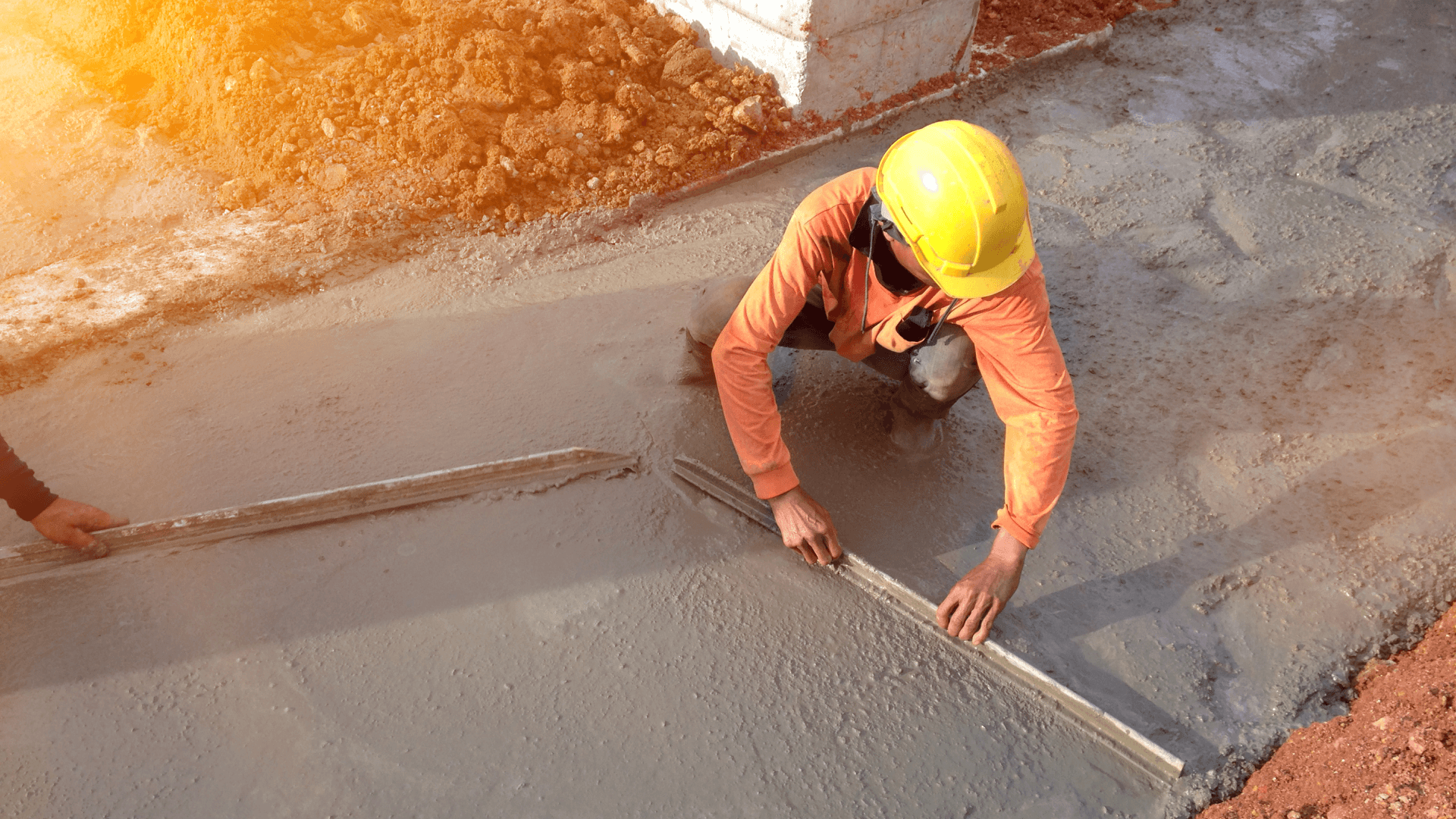
The Colombian-based cement manufacturer Cementos Argos wasn’t trying to start a revolution when they decided to do something novel at their new plant in Rio Claro — they were just responding to the results of a recent cost analysis. Demand for cement was forecasted to grow in Bogotá and Medellín due to planned development and infrastructure projects. “We needed to increase our production capacity,” recalls Daniel Duque, Future Tech Leader of Cementos Argos. There were two ways to do that. The first was to add a new production line to create more clinker, the glue that binds concrete, manufactured by heating limestone. The other was to experiment with a new material: calcined clay.
Typically, a company like Argos would look to “supplementary cementitious materials” like fly ash (a byproduct of burning coal to produce electricity) or slag (a byproduct of steel production) to mix with clinker to make cement. However, those materials weren’t available nearby — and clay was.
Argos ran a cost analysis and found that with calcined clay, “the investment — for building a facility, new equipment, and operating expenses — was lower,” Duque said.

Cement is the most common building material in the world. Globally, some 30 billion tons of concrete — cement combined with an aggregate such as gravel or crushed stone and sand — are produced annually. About half of this concrete is used for buildings and the other half for roads and infrastructure, and its use is increasing rapidly.
The most common type of cement, Ordinary Portland Cement (OPC), is currently responsible for about 8% of total global greenhouse gas emissions. As such, there is an urgent need to reduce emissions from cement production, but most existing methods are either expensive, too early in development, or both. However, the need for action is immediate, given that the Paris Agreement calls for a 50% reduction in global greenhouse gas emissions by 2030.
As Argos discovered, making cement with calcined clay led not only to cost savings but also to a lower carbon footprint. In fact, relying on calcined clay could reduce cement emissions by 40% and help prevent 500 million tons in emissions every year by 2030. For Argos, using calcined clay also helped address the shortage of slag and fly ash that resulted from limited supply.
Since construction was completed in April 2019, the Rio Claro plant has produced more than 2 million tons of cement — proving at scale that making cement with calcined clay is possible and practical. “They have built highways, bridges, tunnels, high-rise buildings, everything,” said Fernando Martirena, Principal Consultant for the Swiss company Ecosolutions, who provided an initial assessment of raw materials for Argos. “They have become a model.”
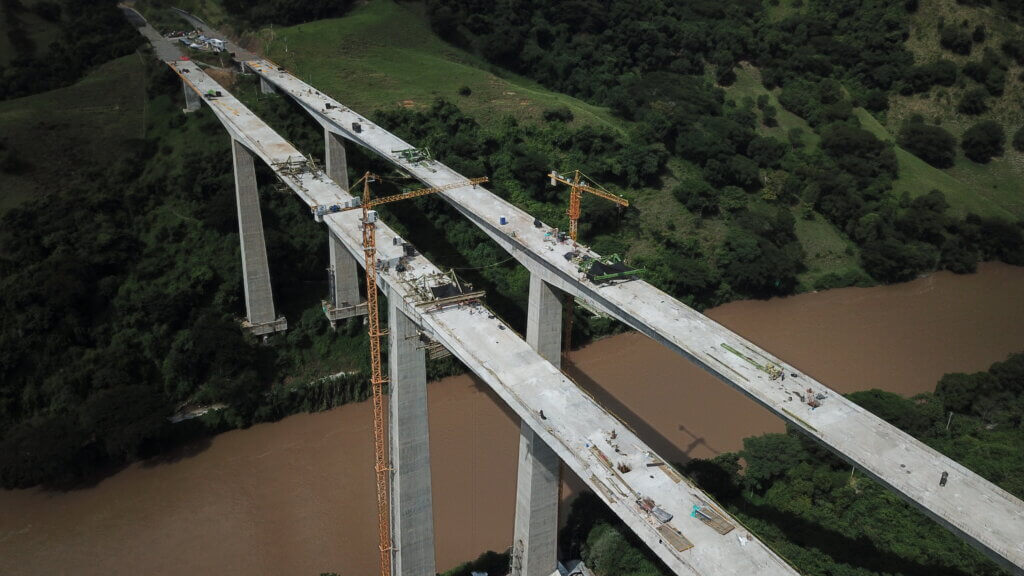
A decades-long quest
For Martirena, seeing the Rio Claro plant succeed was a milestone in a decades-long quest. “It was a dream of mine to come up with a cement that was much more sustainable than the Portland cement,” said Martirena, who had begun experimenting with clay and biomass as building materials for housing in Cuba in the 1990s. “The idea was to develop a toolkit of technologies that could be implemented in developing countries.”
In the early 2000s, Martirena met Karen Scrivener, a materials scientist at the Swiss Federal Institute of Technology Lausanne (EPFL) who now leads the LC3 Project with support from ClimateWorks. Together, Martirena and Scrivener carried out two projects funded by the Swiss National Science Foundation. Concretes made using calcined clay were not new — for example, they were used as fillers in the 1930s for the piers of the Golden Gate Bridge in San Francisco. Until recently, high-purity, kaolinitic clays, which are scarce and expensive, were the only available material for commercial use.
In contrast, Martirena and Scrivener resolved to work with low-grade clays that can be found nearly everywhere in the world. Widespread availability was a crucial factor, as the goal was to make low-carbon concrete available in the places that need it most — and for over 1 billion people who are inadequately housed. In the coming decades, urbanization and population growth will further increase demand for housing and infrastructure — particularly in Asia and Africa, where the population is expected to grow by 1 billion by 2050. Unlike limestone, clays are widely available in all these regions.
Through their collaboration, Scrivener and Martirena experimented on various formulas for cement that led to a breakthrough of what is now called Limestone Calcined Clay Cement, or LC3. Martinera recalls Scrivener saying, “We’re seeing here a novel system — a synergy between the alumina in the clays and the carbonates in the limestone.”
After observing the clay and limestone reaction, Scrivener created a new formula — a combination of clinker, calcined clay, limestone, and gypsum — that made it possible to reduce the clinker content of cement to 50% and lower while maintaining its properties. At that moment, the pair understood they were on to something huge.
Clinker is responsible for some 85% of the emissions from concrete production. The fuel needed to heat the limestone releases carbon dioxide (CO2), and the chemical breakdown of lime when heated to high temperatures also yields pure CO2. As a result, reducing clinker content is a hugely effective way to make cement greener. Calcined clay is also heated but at a lower temperature than clinker, requiring less fuel. And it does not rely on a carbon-releasing chemical reaction.

In 2019, with funds from the Swiss Government and a Portuguese company, Martirena established a pilot plant in Cuba to do industrial tests of LC3. The lab is now a key asset for Technical Resource Centre Latin America (TRC Latin America) — which in turn was founded as a joint action of the LC3 Project with the goal of wider global reach — and provides samples for partners globally.
Tests have found that LC3 is better for the climate and more economical to produce; it also has greater durability in marine climates. In Cuba, Martirena’s team erected huge blocks of LC3 at an exposure site off the coast to see how they weather over time. “We call it the torture chamber for concrete because you have a very high temperature, you have tidal wet/dry cycles in the day, you have hurricanes, you have everything you can think of,” said Martirena. Each year, they drill cores to forecast durability, and results so far show superior performance.
LC3 is also less pervious than other concrete, which means that it absorbs less of the materials that typically cause concrete to degrade over time, like de-icing salt and water.
Laying the groundwork around the world for LC3
With the breakthrough achieved in creating LC3, the next step was to bring the technology to where it was needed most, which involved engaging with a global network of researchers and scientists. “The beauty of working with Karen Scrivener is that she has PhD students from around the world,” said Martirena, who contacted Scrivener’s former student, Shashank Bishnoi, now a professor at IIT Delhi, to collaborate on bringing LC3 to India.

The initial idea was to test some materials and map the viability of LC3 in the country, but Bishnoi soon developed a full-blown action plan. For LC3 to make an impact, he knew that “the cement industry has to accept it, and the Standards Agencies have to accept it.” The LC3 Technology Resource Centre Asia (TRC Asia), housed at the Indian Institute of Technology Delhi (IIT Delhi), was created, and Bishnoi began directing an ambitious program that sought not only to merely understand and quantify things like strength, durability, and CO2 emissions reductions but also the practical side of LC3.
Bishnoi and his team expedited the process by which the Bureau of Indian Standards accepted LC3 and worked to demonstrate its cost-effectiveness to companies. “We had to understand the economic aspects because the industry would never accept a new product if it was going to be more expensive,” he said. The Center focused on information gathering and sharing, running workshops, training programs, and “Information Days” to showcase the technical, financial and environmental advantages of LC3.
Today, the LC3 center in Delhi works with companies in 55 countries around the world. Bishnoi is amazed at the center’s growth trajectory since that initial phone call years ago. “We knew it was going to work, but we never thought so many people would suddenly take it up,” he said. Initially, “it was us chasing the companies to accept the technology, to listen to us, to trust us.” Now, he said, “it’s people coming to us and asking us.”
Even the most change-averse industries will need to get on board. In India, the railway industry is “one of the most conservative in adopting new technologies,” said Bishnoi. So he made a roadmap for the industry, suggesting the use of LC3 for masonry plaster and roads in the first year. Eventually, the plan outlines working up to small buildings and then to four-story buildings, small check dams, railways over bridges, and long bridges, building confidence and troubleshooting along the way.
Bishnoi points out that India is adding new cement capacity at around 35 million tons per year — equal to the amount of cement in all of Germany’s existing infrastructure. If the transition begins now, Bishnoi estimates that 50% of cement produced in India by 2030 could be LC3.
Launched in February 2024, the most recent LC3 Technical Resource Centre to join those established in Cuba under Professor Martirena and at IIT Delhi under Bishnoi is the Technical Resource Centre Africa (TRC Africa), housed at the Meru University in Kenya. “Africa is where we expect a lot of massive infrastructure to be constructed in the next few decades, where we expect a lot of housing,” said Joseph Marangu, who directs TRC Africa. “Sub-Saharan Africa has the highest urbanization rates, as well as the population growth, which is driving the demand for housing, road connectivity, and water infrastructure like dams.”

TRC Africa is already receiving a lot of attention. The center supports ongoing projects in Malawi and Senegal, and additional cement companies have reached out from Rwanda, Senegal, Malawi, and Kenya. At the center, geologists help identify the kaolin clays that are geographically close to the cement company. Typically, Marangu said, these can be found within a 200-kilometer radius, which makes the uptake of LC3 financially viable.
Marangu’s long-term goal is for at least one cement company in each of the 48 countries in Sub-Saharan Africa to produce LC3. It would make the work of the TRC Africa easier if companies “have a reference from each country where they will see how the technology works,” he said. In the meantime, Marangu is focused on acquiring equipment for his lab and working to secure the resources needed to hold Information Days in the geographies his Center intends to serve.
Philanthropy’s opportunity to scale low-carbon cement
What makes LC3 unique as a climate solution is its “huge potential to scale,” according to ClimateWorks’ Industry Program Strategist Scott Shell. Carbon capture is exciting but expensive. As for novel low-carbon building materials like Brimstone or Sublime, Shell says, “We are rooting for them, but they are still very early. None of them have a full-scale plant yet. We don’t know if they’ll be affordable or not.” LC3, by contrast, is ready now, and it is ready to go to work anywhere.
Shell is part of ClimateWorks’ Industry Program, which is working to reduce industrial greenhouse gas emissions from cement, steel, and chemicals to zero in high-income countries by 2050 and in middle- and lower-income countries by 2060. Key to this goal is supporting the development and scaling of low-carbon cement in emerging economies.

Philanthropy can and has played a crucial role in accelerating the transition to low-carbon building materials. In the United States, for example, advocacy funded by philanthropy helped tip the balance toward the launch of the Federal Buy Clean Initiative in 2022, which requires the procurement of low-carbon materials on public construction projects. This initiative has major ramifications given that the U.S. Federal Government is the world’s largest purchaser of goods and services.
Similarly, philanthropy supported efforts that helped pave the way for the signing of the landmark Inflation Reduction Act in 2022 — the most significant investment ever for industrial decarbonization — which includes $6 billion for the U.S. Department of Energy for advanced industrial demonstration projects, six of which are calcined clay or LC3 projects. “That’s just a transformative investment,” says Shell. “And that wouldn’t have happened without climate philanthropy, including ClimateWorks and all of the civil society that helped advocate for that legislation.”
There is much more that philanthropy can do to help scale low-carbon cement, including efforts beyond policy advocacy. For example, philanthropy can help gather players in the building industry who would not normally be in a room together to share research and spur collaborations. Additionally, philanthropy can continue to facilitate testing and demonstration projects using LC3 and support the education projects necessary to transfer knowledge of LC3 from researchers to industry.
As the cement industry is already starting to realize, LC3 is a proven, economical solution for decarbonizing cement. “This is the real deal,” said Martirena. “It is simple and robust.”

After the hottest year on record, 2024 has continued to bring unprecedented heat and extreme weather events. Today, 80 percent of people globally want their country to do more on climate change. The calls for bold action are louder than ever, and much more is needed to course correct to achieve a sustainable and just future for all people.
The Center for Effective Philanthropy’s 2022 report, Much Alarm, Less Action, highlighted the gap between rising concern and concrete action in addressing the climate crisis within philanthropy. Two years later, the landscape has shifted significantly, with philanthropy organizations increasingly stepping up to help bridge this gap and drive innovative solutions to address this global emergency.
Progress and Peril Halfway to 2030
At the midpoint of the 2020s — the decisive decade for climate action — we face two realities: significant progress and escalating urgency. On one hand, we’ve seen remarkable strides in global climate action, benefiting public health, livelihoods, and the climate. To name a few examples:
- Renewables are now the cheapest form of power.
- The transition to clean transportation, spurred by electric vehicle sales, is accelerating faster than anticipated.
- Philanthropy and the broader civil society climate action community have grown more numerous, diverse, and agile, moving with greater scale and speed.
These successes lay a solid foundation for continued progress. However, current global action does not align with the Paris Agreement’s goals, and many communities still lack the resources needed to respond effectively to the accelerating pace of climate change.
Here’s how philanthropy is adapting in addressing the climate crisis.
Prioritizing Implementation
The world has made progress toward avoiding the most dire climate projections, with current policies aiming to limit warming to between 2.5° C and 2.9° C. But even this level of warming would be devastating to nations and communities around the world. The good news is that nearly 145 countries have announced or are considering net zero targets, covering close to 90 percent of global emissions. Now is the time to turn these promises into action.
Climate funders are increasingly focused on supporting the implementation of existing policies and pledges. Funder collaboratives like the Drive Electric Campaign and Forests, People, Climate are central to this effort, mobilizing resources to accelerate shifts in key areas while strengthening coordination across sectors and geographies to drive impactful solutions at scale. Hewlett Foundation’s updated climate initiative strategy also emphasizes the need to support countries and industries in fulfilling their climate commitments, reflecting a broader shift toward improved coordination in climate action across all sectors of society, including philanthropy, businesses, governments, and communities.
Significant climate policy wins over the past few years, like the U.S.’s Inflation Reduction Act and the EU’s Fit for 55, have been shaped, in part, by philanthropy and lay out a clear path for continued philanthropic engagement to help realize their full potential. Philanthropy now has the opportunity to build on these successes to unlock more finance for implementation, including greater resources for underrepresented sectors and geographies.
Expanding Beyond Mitigation to Adaptation and Resilience
Philanthropy is also expanding its focus beyond climate mitigation to help communities adapt to the impacts of climate change being felt today. This work is particularly compelling for funders new to climate issues, as it connects directly with their existing priorities and the communities they serve, which are increasingly affected by the climate crisis.
An example is the Adaptation and Resilience Funder Collaborative, launched at COP28. This collaborative brings together more than 50 foundations focused on climate adaptation and resilience. In response to the UN Secretary-General’s call to action on extreme heat, a group of these philanthropies made an initial commitment of $50 million to support adaptation and resilience efforts in regions most vulnerable to the impacts of climate change.
Innovative approaches supported by philanthropy include piloting community-based parametric insurance in India, building coalitions to advocate for debt reform for small island developing states, fostering entrepreneurship in East Africa to develop cold chain infrastructure, and scaling the use of solar-reflective ‘cool’ roofs.
Expanding Support for Communities Worldwide
As funding for climate action has grown, so has the climate philanthropy ecosystem. According to ClimateWorks Foundation data, the number of grantees receiving climate change mitigation funding has nearly doubled from 2015 to 2021, and foundation funding continues to grow steadily each year. More foundation funding is now reaching regions outside the geopolitical north, with significant growth in Africa, India, and Latin America. However, these locations still represented only 12 percent of total foundation funding for climate change mitigation.
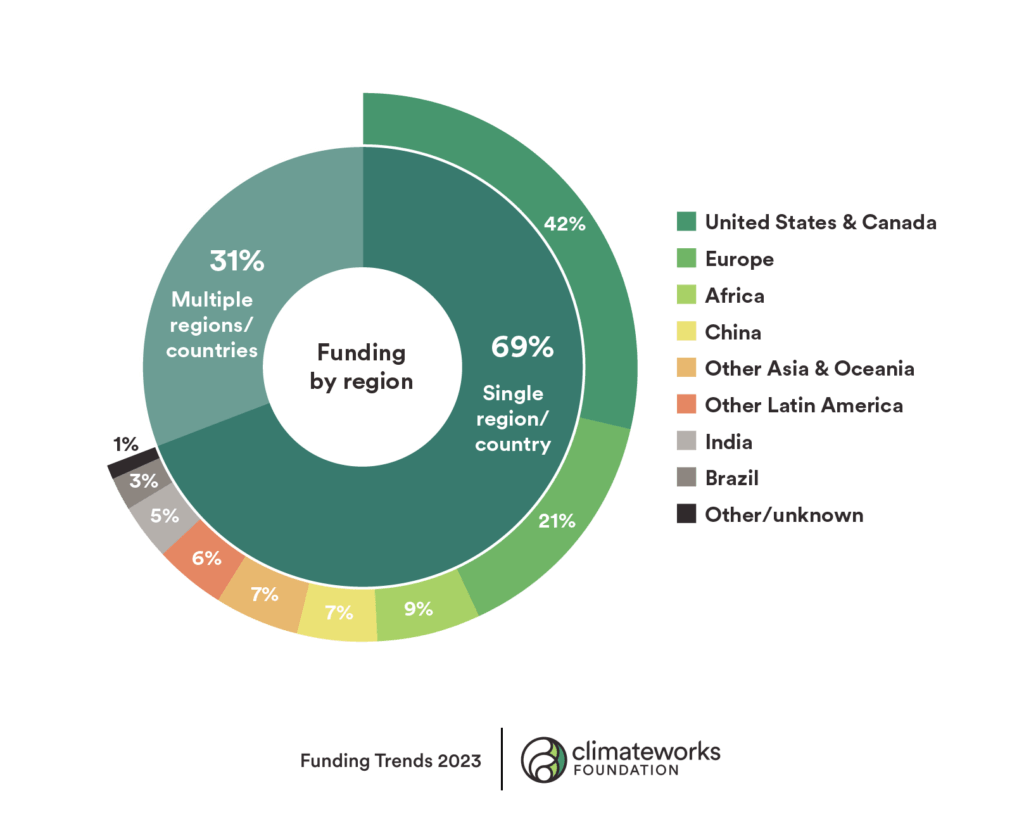
This expansion of funding and support must continue to catalyze more transformative action.
In addition, intermediaries will continue to play a critical role in increasing funding for climate action by coordinating efforts and connecting funders to local experts implementing change on the ground. There is an expanding and diverse constellation of intermediaries for funders to work with, from those that take a global view to those that are movement-accountable, geographic (Viriya ENB, African Climate Foundation, and Instituto Clima e Sociedade), or sectoral (Global Methane Hub).
Climate Philanthropy in a Changing World
This moment is crucial not only because we are halfway through the decisive decade but also because 2024 is one of the most significant election years in history. With nearly half of the world’s population casting votes, the outcomes will shape the pace and scale of climate action for decades to come.
As these elections unfold, they are spotlighting the kitchen table issues that people care about most — issues like economic opportunity, health, education, safety, and more. This presents an opportunity to clearly demonstrate how climate is not just about the environment but about all the things people hold dear. Philanthropy has a vital role in amplifying this message, increasing participation in climate solutions, and building broad-based support by showing how these solutions benefit people, communities, and economies alike.
In addition to growing support for adaptation and resilience, efforts like the IKEA Foundation’s just transition initiative, which centers community voices in the geopolitical south’s energy transition, exemplify how philanthropy is working in new ways to foster more inclusive climate action.
Expanding Diversity and Access in Climate Philanthropy
Amid the need to broaden global support for climate action, the movement to embrace justice, equity, diversity, inclusion, and belonging has never been more essential. This means focusing on people and emissions reductions, moving more resources to the geopolitical south, addressing overlooked issues like intergenerational equity, and adopting a less directive approach in grantmaking. There is a lot of momentum toward justice and equity within philanthropy, and funders need to keep pushing in this direction faster.
Looking Ahead: Amplifying Philanthropy’s Impact
The next five years will be pivotal in determining whether we can achieve the progress needed to meet the Paris Agreement goals, support those feeling the impacts of climate change today, and secure a more sustainable and equitable future.
As the landscape of climate giving evolves, philanthropy has immense potential to catalyze transformative change. The path ahead requires our collective effort. As Christiana Figueres, one of the key architects of the Paris Agreement, said, “This is the decade, and we are the generation.”
Climate change is a wicked problem that demands every lever at society’s disposal be used to solve it — and philanthropy is critical to unlocking the financial and human capital needed to move from climate progress to climate solutions. Whether you are well into your climate journey or are just starting to think about what you might do, there’s never been a better nor more important time to make your mark. What steps might your philanthropy take today to contribute to a more secure, just, and brighter future for all?
This post was originally published on the Center for Effective Philanthropy’s blog here.

